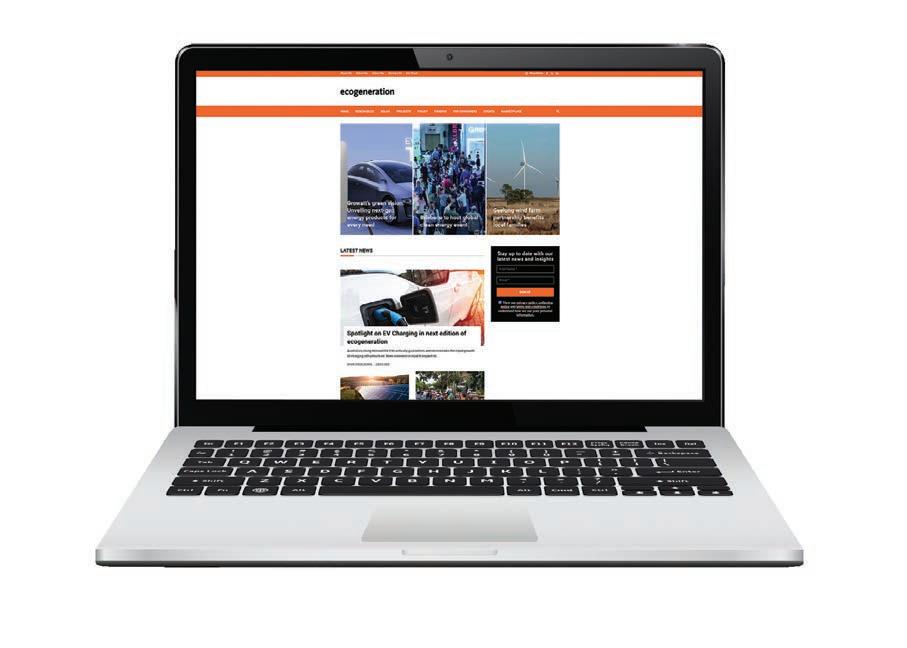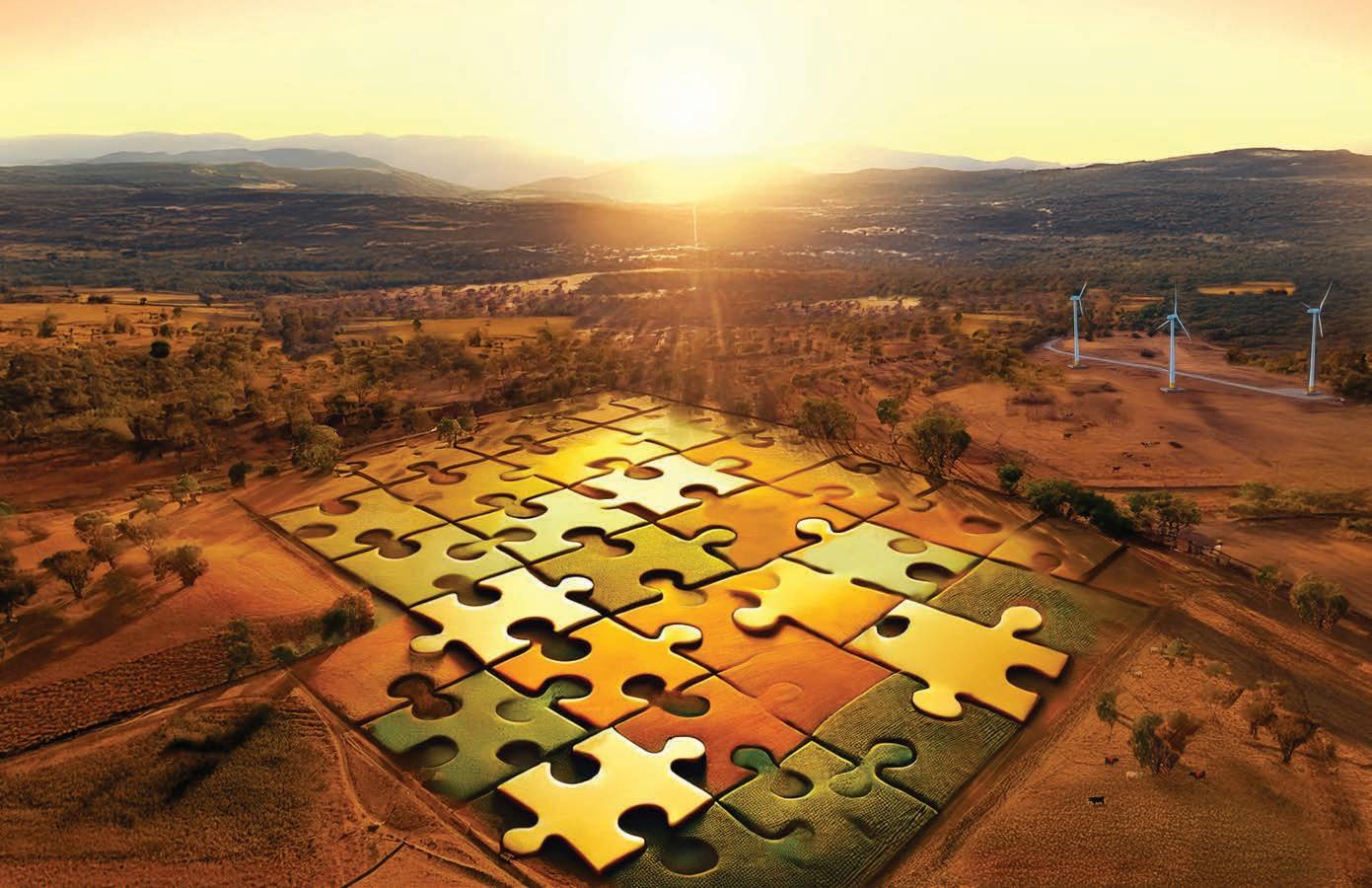
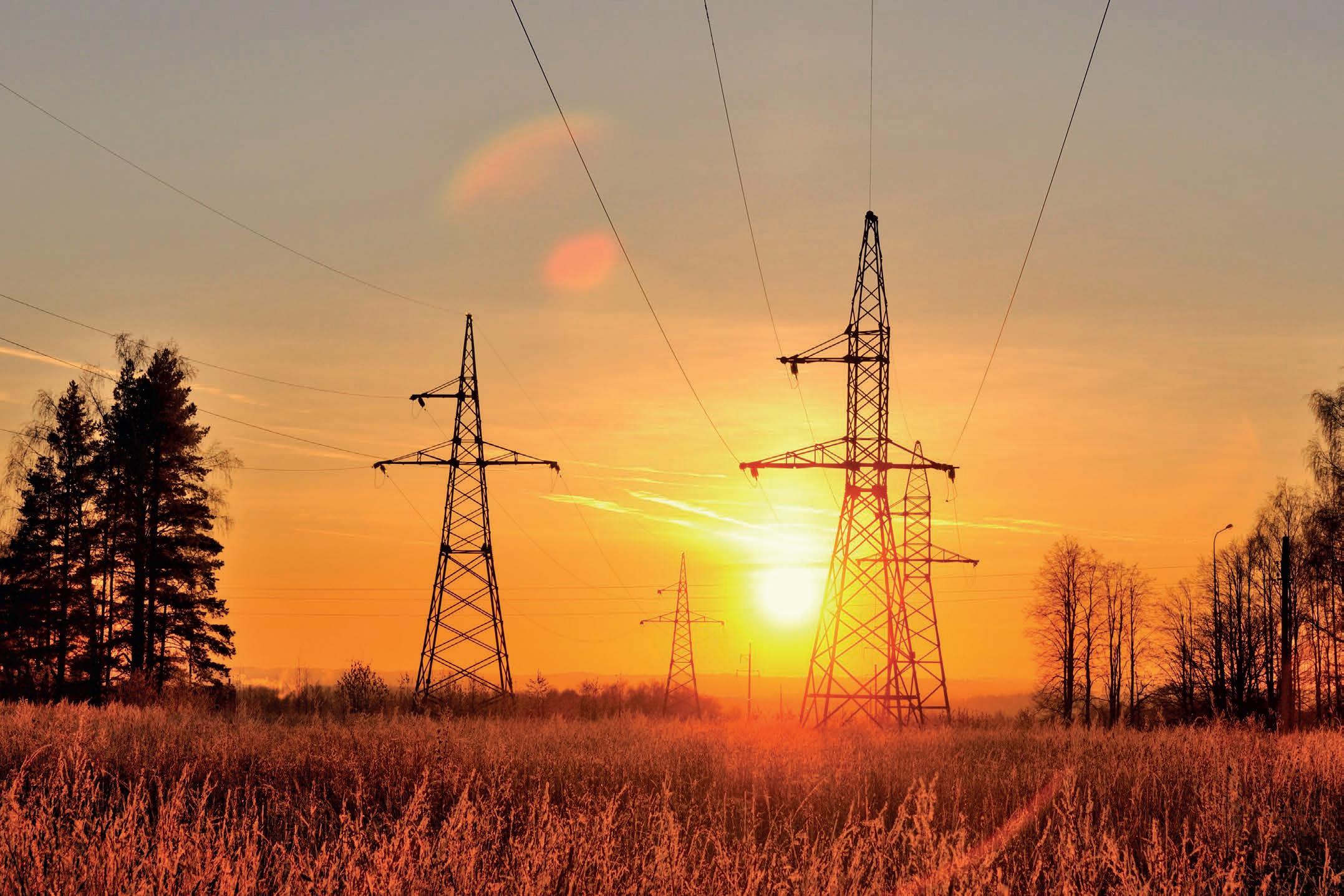



From linemen to landholders, utility-scale renewables are reshaping the landscape
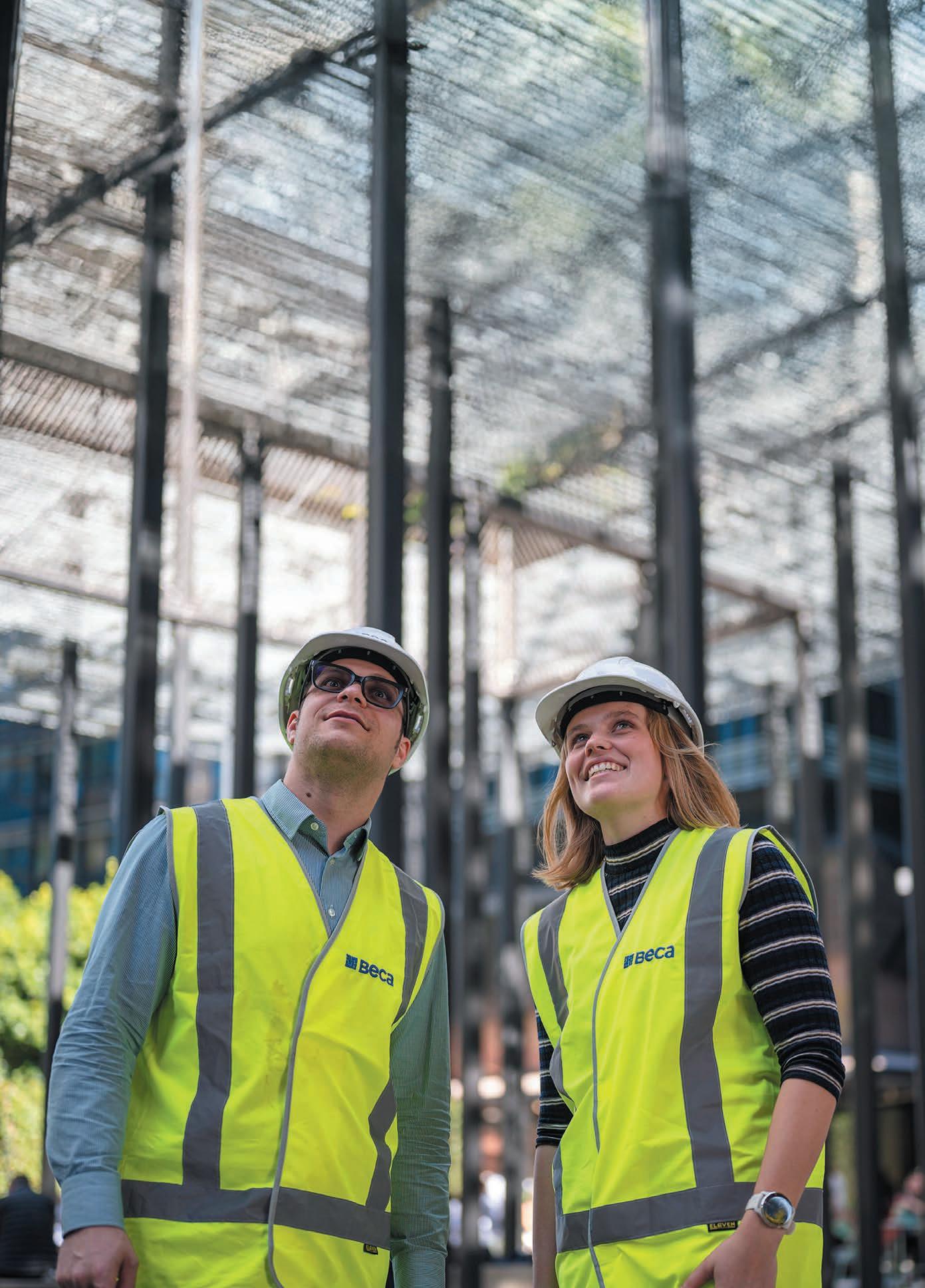

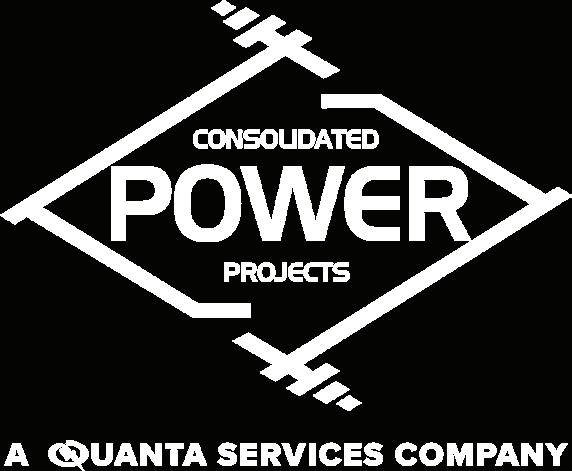



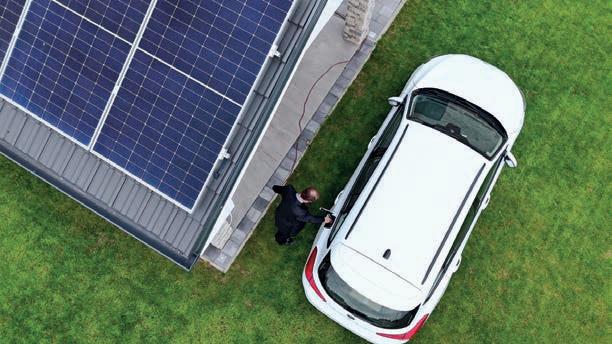















*Source: S&P Global
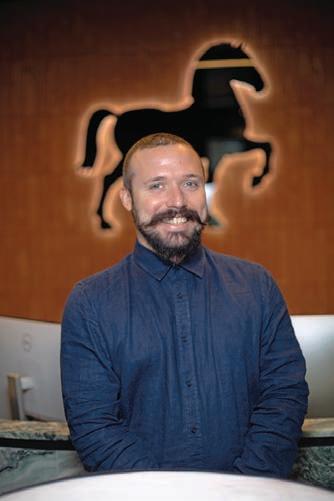
Welcome to the August edition of ecogeneration, where we bring you a sweeping view of Australia’s fast-moving clean energy transition.
The industry is no stranger to pressure, be it technical, political, or economic, and this month’s issue explores how resilience is being tested, shaped, and renewed across the sector. From a milestone of 15 years of renewable industry endurance, to insights on market volatility and the growing capital needed for change, momentum is being maintained.
Our regional reports offer a timely snapshot of several states. Queensland, NSW, Victoria and WA each present different policy settings and investment landscapes, but all are grappling with similar issues, including how to secure supply, attract talent, and manage the rising demands of the grid and its users.
At utility scale, the momentum continues. Record-breaking 500kV work highlights the scale and complexity of modern transmission, while innovations in solar, storage and stakeholder engagement show just how much ground is being covered – from storage ambitions to strategic growth. In a nation still driven by resource industries, we note Australian aluminium is playing a pivotal role in global solar growth.
This issue also steps inside the boardrooms and paddocks where deals are made and community support is won. Empowering landholders, decoding consumer behaviour, and strengthening public trust are central to building a truly integrated, equitable transition.
From battery breakthroughs to workforce development, the innovation pipeline is packed. However, as our experts and insiders remind us, progress depends as much on collaboration and clarity as it does on capital. Whether designing safer batteries, buying clean power in a choppy market, or planning the next storage megaproject, success hinges on shared intent and smart execution.
Events coverage and company news round out the issue, including the industry milestones and strategic shifts shaping the months ahead.
Thanks for picking up this edition of ecogeneration. We hope this issue sparks ideas, conversations, and connections that power your work forward.
Tim Hall ecogeneration Editor

Follow ecogeneration on LinkedIn
ecogeneration acknowledges the Cammeraygal people, traditional custodians of the land on which this publication is produced, and we pay our respects to their elders past and present. We extend that respect to all Aboriginal and Torres Strait Islander people today.
For the latest industry news, sign up for the FREE
Chief Executive Officer: Christine Clancy
Chairman: John Murphy
Editor: Tim Hall tim.hall@primecreative.com.au
Business Development Manager: Nick Lovering , +61 414 217 190 nick.lovering@primecreative.com.au
Client Success Manager: Karyssa Arendt karyssa.arendt@primecreative.com.au
Head of Design: Blake Storey
Designer : Apostolos Topatsis
Subscriptions : T: +61 3 9690 8766 subscriptions@primecreative.com.au
Published by: PRIME CREATIVE MEDIA PTY LTD
ABN: 51 127 239 212 379 Docklands Drive
Melbourne VIC 3008, Australia T: +61 3 9690 8766 www.primecreativemedia.com.au
www.ecogeneration.com.au

Cover image: Sergey Eshmetov/stock.adobe.com
ecogeneration is printed on Lumi paper which is PEFC-certified and manufactured in an ISO 14001-certified mill. Lumi paper also contains premium white waste paper, reducing matter going into landfill. This magazine is available to interested parties throughout Australia and overseas. The magazine is also available by subscription. The publisher welcomes editorial contributions from interested parties, however, the publisher and the Editorial Board accept no responsibility for the content of these contributions and the views contained therein are not necessarily those of the publisher or of the Editorial Board. The publisher and the Editorial Board do not accept responsibility for any claims made by advertisers. Unless explicitly stated otherwise in writing, by providing editorial material to Prime Creative Media, including text and images, you are providing permission for that material to be subsequently used by Prime Creative Media, whole or in part, edited or unchanged, alone or in combination with other material in any publication or format in print or online or howsoever distributed, whether produced by Prime Creative Media and its agents and associates or another party to who Prime Creative Media has provided permission.
Average net distribution 6616 Period ending September 2021
and check out our website at
Households and small businesses are now able to access federal rebates for solar batteries, following a regulatory amendment that adds battery storage to the Small-scale Renewable Energy Scheme (SRES).
The Renewable Energy (Electricity) Amendment (Cheaper Home Batteries Program) Regulations 2025, which became law on 27 June, expands the existing Renewable Energy (Electricity) Regulations 2001.
The changes support the rollout of the Federal Government’s Cheaper Home Batteries Program, offering upfront discounts of around 30 per cent on installed battery costs – roughly $3000 off an eight kilowatt-hour (kWh) system.
The program leverages the established small-scale technology certificate (STC) mechanism, used for rooftop solar, to subsidise battery installations.
Under the new rules, households and
businesses installing compliant battery systems with new or existing solar systems can generate STCs based on the battery’s usable capacity – up to 50kWh – multiplied by a year-specific factor. For 2025 installations, the factor is 9.3, tapering annually through to 2030.
The Commonwealth will directly purchase the STCs created through battery installations, shielding electricity consumers from any cost pass-through by liable entities such as retailers.
To qualify, batteries must be listed on the Clean Energy Council’s approved product list and sized between five kWh and 100kWh nominal capacity.
All installations must meet rigorous design, safety, and compliance conditions, including adherence to AS/ NZS 5139 battery safety standards and VPP (virtual power plant) readiness for grid-connected systems.

After years of sluggish gains, the pace of global energy transition has picked up, according to the World Economic Forum (WEF).
The WEF has released a new Energy Transition Index (ETI), benchmarking 118 countries, recorded its strongest annual improvement in a decade – up 1.1 per cent year-on-year – signalling a broadbased but uneven recovery.
The latest data shows significant strides in energy equity and sustainability, buoyed by easing energy prices, targeted subsidy reforms and increased clean energy penetration.
Electricity systems reached a record 49 per cent clean energy share, with renewables, storage and AI-driven smart infrastructure accelerating decarbonisation efforts.
However, the report warns of
persistent fragilities.
Energy security remains the lagging dimension, improving by just 0.4 per cent in 2025. Grid inflexibility, high import dependencies and sluggish diversification continue to expose vulnerabilities – particularly as energy demand surges from electrification and AI-driven data centres.
“Despite the rapid expansion of renewable energy and clean energy technology diffusion, energy and emission intensity remained relatively high,” the report states.
“Meanwhile, energy supply flexibility and diversity could be further strengthened to augment energy security.”
Investment momentum also appears at risk.
While clean energy investment surpassed US$2 trillion globally in 2024, annual growth slowed to 11 per cent –down from 29 per cent three years earlier. Financing challenges remain acute in emerging economies, where capital costs are up to seven times higher than in developed markets, despite accounting for over 80 per cent of new energy demand.

Only 28 per cent of countries made progress across all three pillars of the
energy trilemma – security, equity and sustainability.
Sweden, Finland and Denmark retained the top rankings, underpinned by robust infrastructure, diversified lowcarbon energy systems and long-term policy coherence.
China reached a record 12th place, reflecting its scale in clean energy investment and innovation.
The US, ranked 17th, led the energy security dimension, while Nigeria and the United Arab Emirates posted some of the fastest year-on-year improvements, driven by infrastructure upgrades and reforms.
The report identifies five strategic priorities to build resilience and sustain progress: adaptive policy frameworks, modernised infrastructure, skilled workforce investment, technology commercialisation and targeted capital deployment in developing economies.
But the path is still not clear.
“There is no single blueprint,” the Forum states.
“Countries will follow different paths at different speeds. Ensuring a durable and inclusive transformation requires alignment between ambition, finance and delivery – guided by market signals, grounded in local realities and supported by international cooperation.”
A new report plots the opportunities for renewable energy projects across Australia.
AEMO’s 2025 Enhanced Locational Information (ELI) report highlights increasing locational risks and opportunities across the National Electricity Market (NEM), with a sharp focus on curtailment, congestion, and hosting capacity.
The report consolidates public data from AEMO’s own forecasts, industry publications, and government plans, aiming to streamline early-stage investment decisions. It is a key output of the Energy Security Board’s transmission access reforms.
“There are approximately 20 gigawatts of projects currently at the application to connect stage, as well as the 300 GW of proposed future projects,” said AEMO Executive General Manager of System Design, Merryn York.
“This report presents key locational data to help investors understand where their projects are most likely to succeed.”
The report reveals that, while most NEM transmission lines did not face major congestion in 2024, bottlenecks persisted – particularly in Western NSW and North West Victoria.
Curtailment affected over 25 per cent of output for several solar farms in these areas. In contrast, more than 60 per cent of all grid-scale renewables across the NEM experienced
curtailment under one per cent.
Curtailment is forecast to remain elevated in South Australia and Victoria through 2026–2028 due to system security constraints and limited export capacity. Modelling shows improvement by 2030 to 2035 as key ISP transmission projects are commissioned.
AEMO has also introduced a “network hosting capacity” metric, estimating the maximum additional renewable generation each of 158 locations can accommodate before hitting 20 per curtailment.

Results favour hybrid configurations – solar or wind paired with two-hour battery energy storage systems (BESS) – which typically offer higher hosting capacity. However, in highly congested areas, even hybridisation shows diminishing returns.
To support decision-making, AEMO has mapped marginal loss factors (MLFs) and introduced robustness scores indicating the sensitivity of existing MLFs to new nearby generation.
Delivering expert electrical solutions for renewable infrastructure –from Solar PV and BESS to Wind, Hydrogen, VPPs, and next-gen energy systems.

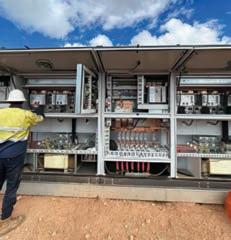

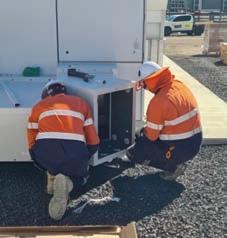
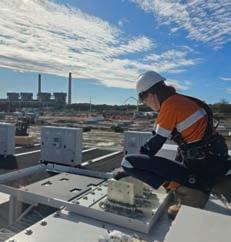
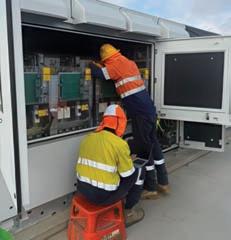


AEMO has renamed its delivery arm in a renewed push to drive clean energy investments.
The Australian Energy Market Operator (AEMO) has renamed its infrastructure delivery subsidiary AEMO Services Limited to AusEnergy Services Limited.
The name change, effective from 30 June 2025, reflects the organisation’s expanding role as an independent, purposebuilt entity delivering public value through
energy infrastructure investment. It will continue to be referred to as ASL to maintain continuity and recognition across industry and government stakeholders.
ASL remains a subsidiary of AEMO, with both AEMO and the NSW Government retaining their positions as members. The rebranded organisation will continue its work under the NSW Electricity Infrastructure Roadmap and the Commonwealth Government’s Capacity
New funding is aimed at a myriad of green power innovations.
The Clean Energy Finance Corporation (CEFC) has committed $15 million to Climate Tech Partners Fund I, backing early-stage climate technologies with the potential to cut emissions across energy, transport, and industrial sectors.
The investment, made via the Powering Australia Technology Fund, is intended to catalyse commercial-scale outcomes in an innovation market facing tightening capital conditions.
The fund targets companies with commercially viable technologies capable of rapid emissions reductions at scale.
It spans sectors including nextgeneration grids, sustainable fuels, and electrification – areas currently aligned with both corporate decarbonisation goals and Australia’s long-term climate targets.
While the CEFC emphasises commercial scaling and exposure to
market competition, this investment comes amid a global downturn in growth-stage funding.
According to the IEA’s State of Energy Innovation report, venture capital for growth-stage climate tech fell by 23 per cent in 2024. Start-ups with high capex demonstration projects were particularly affected, with financing concentrated in North America, Europe, and China.
The Fund’s structure includes close collaboration with end users, aiming to de-risk investments and compress timeto-market through prototyping and manufacturing support.
“This investment supports the advancement of technology essential to Australia’s climate transition – including rapid prototyping, manufacturing, and exposure to market competition,” said CEFC Head of Growth Capital Malcolm Thornton.
The IEA estimates that 35 per cent of the emissions reductions required to
Investment Scheme (CIS).
“ASL will continue to operate as an independent subsidiary of AEMO, and both AEMO and the NSW Government remain members,” the organisation said.
Nevenka Codevelle has been formally appointed as the inaugural Chief Executive Officer of AusEnergy Services Ltd. Ms Codevelle has led the organisation since December 2023 and was previously AEMO’s Executive General Manager Government and Stakeholder.
“Her reappointment reflects the ASL Board’s confidence in her leadership and continued commitment to the organisation’s vision and purpose,” ASL said in a statement.
Under its role as the NSW Consumer Trustee, ASL has already supported over 2.4 GW of generation, 1 GW of firming, and 1.6 GW of long-duration storage.
Together with AEMO, it has recommended more than 6 GW of generation including over 3 GWh of hybrid storage and 6 GWh of clean dispatchable capacity to the Commonwealth under the CIS.
These efforts will continue, with ASL and AEMO jointly supporting future CIS tenders to accelerate Australia’s clean energy transition.
“The name change reflects ASL’s role as the purpose-built independent organisation delivering energy infrastructure investment programs on behalf of governments, with a focus on transparency, competition and public value,” ASL said.
reach net zero by 2050 depend on technologies not yet proven at commercial scale.
Australia’s targeted support for earlystage companies may help close that gap, particularly if coupled with improved access to demonstration funding and infrastructure.
Many see the opportunity.
“We’re seeing a wave of breakthrough climate tech – electrification, sustainable fuels, next gen grids – gaining real traction,” said Climate Tech Partners CoFounder Patrick Sieb.
“With tech readiness, corporate demand, and policy aligning, it’s a powerful moment to invest.”
The CEFC’s backing also signals confidence in the Fund’s venture model, which taps into existing corporate demand to guide capital allocation. This approach aligns with recent IEA calls to tailor support mechanisms to the unique innovation and scale-up needs of each sector.
Australia is gearing up to become a global force in low carbon liquid fuels (LCLFs).
New modelling indicates a potential $36 billion domestic market by 2050 – driven largely by the agricultural sector.
A report commissioned by the Clean Energy Finance Corporation (CEFC) outlines a blueprint for scaling a sovereign low carbon liquid fuel (LCLF) industry to support decarbonisation across hard-to-electrify sectors.
The study highlights that 56 billion litres of liquid fuels are consumed annually in Australia, accounting for around 32 per cent of national emissions.
Sectors like aviation, heavy freight, mining, rail, maritime and construction – many of which are resistant to electrification – will still require up to 30 billion litres by 2050, even under aggressive electrification scenarios.
LCLFs, produced from renewable biogenic feedstocks such as canola,
sugarcane, animal fats and waste oils, offer a cleaner alternative to fossil fuels. These drop-in fuels are compatible with existing infrastructure and deliver significant emissions reductions without the need for new vehicle or engine technologies.
Australia’s feedstock advantage is a key enabler.
CSIRO estimates biogenic resources could support up to 12.8 billion litres of LCLF production by 2050. Most notably, Hydroprocessed Esters and Fatty Acids (HEFA) and Alcohol-to-Jet (AtJ) pathways align well with Australia’s existing tallow, canola and sugar industries.
Despite global LCLF supply reaching 33 billion litres in 2024, Australia currently refines only 20 per cent of its fuel demand.
The report identifies over 2 billion litres of domestic LCLF production capacity already in the pipeline, with strong investor interest buoyed by Australia’s comparative feedstock advantage and proximity to
Asia- Pacific demand.
Government support is growing, with $250 million earmarked under the Future Made in Australia policy, and state strategies emerging in NSW, Queensland and Western Australia.
However, the report stresses that stronger policy signals – such as blending mandates or long-term offtake agreements – are needed to bridge the cost gap with fossil fuels and de-risk private investment.
An accelerated policy scenario could see LCLFs abate up to 290 megatonnes of carbon dioxide equivalent (MtCO2-e) by 2050, bolstering emissions targets while enhancing fuel security and regional employment.
Without such action, Australia risks being left behind as global competitors scale production in response to aviation and shipping mandates.
The window to establish local production at scale is narrowing as international markets race to secure feedstocks and infrastructure.




Fifteen years ago, the renewable energy industry was a small, niche part of the energy system. There was a great deal of skepticism about clean energy, and no one thought it would play a significant role in the energy mix, writes Kane Thornton.
If renewables in the early 2000s had a personality, they were a bit of an upstart, viewed as the new kid on the block with big, lofty ambitions but lacking sophistication and maturity.
Today, clean energy plays an enormous role in powering Australia’s economy and creating thousands of jobs and economic opportunities for the regional economy. Professionally, it was a privilege to lead the peak body and industry through this extraordinary period of change. Growing up in regional Victoria, I also got to watch the change occurring as renewable energy rebooted regional towns that were otherwise in a slow state of decline.
I grew up outside of Ballarat, between famous clean energy landmarks like the Golden Plains and Waubra wind farms and Victorian Big Battery. This regional community had once thrived on the back of the gold rush, followed by the wool industry. It’s a source of great pride to now see clean energy become the dominant economic driver for this – and many other – regions.
Today, as I reflect on this journey, I am both humbled and inspired by the transformation we have seen – a testament to collective ambition, innovation, and unwavering resilience. A fledgling industry
has grown into an economic powerhouse and Australians have embraced the power of harnessing wind, solar and water to power our homes and businesses.
Growth and momentum: highlights The pace of change and the rate at which we have deployed renewable energy in the past decade has been nothing short of extraordinary. Australia’s energy capacity has surged, with renewables accounting for just over 40 per cent of our total electricity supply.
Households have embraced rooftop solar, with Australia achieving the highest rate of rooftop solar in the world. Rooftop solar now contributes significantly to our energy mix, with solar panels on the rooftops of more than four million homes and businesses.
We’ve seen investments of $40 billion in large-scale renewable energy in Australia in just the past five years.
It’s clear wind and solar, supported by battery storage, pumped hydro and a small amount of gas, is the way forward.
Australia has seen enormous investment in utility scale batteries, with dozens of projects worth over $15 billion in the last three years. This leadership is about to be matched by battery storage in the home,
with the federal Cheaper Home Batteries Program, which kicked off on 1 July, driving massive demand for battery uptake.
The Clean Energy Council has strongly advocated for incentives to support the uptake of solar batteries in Australia as the missing piece in Australia’s energy transition.
Under the federal program, households can access a 30 per cent discount on the upfront purchase price for home batteries with a capacity up to 50 kilowatt-hours (kWh).
In Western Australia, the Residential Home Battery Scheme provides rebates of up to $5000 for Synergy customers and up to $7500 for Horizon Power customers for battery systems up to 10 kWh, with interest free loans of up to $10,000 available for eligible households.
These programs, along with other states offering interest-free loans, are expected to further boost the record $2.4 billion investment in utility-scale batteries and rooftop solar experienced over the past twelve months.
The Clean Energy Council’s investment report: Large-scale renewable energy generation and storage report (Q1 2025) revealed we had our best annual start for new storage projects on record.
Six large–scale storage projects representing 1510 MW / 5016 MWh reached financial close – the second highest quarterly result for new financially committed storage projects.
We also have a large pipeline of advanced stage projects (including almost 10 GW of wind and solar) likely to go ahead
with investment in the near term, many of which are supported by government underwriting contracts.
Despite this we can’t afford complacency if we are to meet the Australian Government’s target of 82 per cent renewable energy by 2030. This requires annual investment commitments in the range of six to seven GW for new large-scale generation capacity every year.
Bumps along the road: future challenges
Our journey, however, hasn’t been without obstacles. One constant over the past 15 years was the constant politicisation of energy and climate policy and the chopping and changing of governments and policy. A steady constant of instability and mixed messages about Australia’s commitment to clean energy.
The period of 2010-2019 saw Australia change prime ministers five times. It is in this context that we excelled at navigating successive changes in both leadership and policies, and helped the industry respond effectively, with the courage and conviction to keep renewables firmly on the table.
We now have cause for hope that these wars are over. The federal election in May was touted as a referendum on energy – and Australians spoke loudly that they support a clean energy future.
I am enormously proud of the role the Clean Energy Council played during the election campaign. We set the record straight, we were assertive, countered
misinformation and disinformation, and made sure people understood the absurdity of pausing renewables and going nuclear.
We have no time to wait.
Renewable energy is here now; we are ready to deliver on a successful transition, and we’ve made incredible inroads across government, industry and the community in the last decade and more.
I am proud to say industry is leaning into the big challenges, improving grid connection, helping to reform environment and planning regimes and developing new models of benefit-sharing with communities affected by large-scale renewable energy infrastructure.
All these initiatives highlight the delicate balance between progress and inclusivity. These are complex problems that no single person or organisation can solve alone.
Looking ahead: hope and ambition
As I contemplate the future, I’m filled with optimism. Australia’s commitment to renewable energy is clear in our ambitious targets, such as the federal goal of reaching 82 per cent renewable energy in the country’s electricity grid by 2030. Innovations in storage, grid management, and emerging technologies promise to further enhance our capabilities.
However, our journey is far from over.
As I step back from my role as CEO of Australia’s largest peak body for the clean energy sector, I do so with immense gratitude – for the colleagues who shared this journey, the communities that embraced
change, and the countless individuals who believed in a cleaner, brighter future.
When I joined the Clean Energy Council 15 years ago, we represented just 100 companies. Today it’s almost 1000. Australia has gone from 15 per cent to 40 per cent on renewables in the energy sector. Doubling this again in the next five years is going to be a lot of work. But I know it is something the Clean Energy Council, working with industry, can do by continuing its advocacy work reforming energy markets, improving planning and environmental regimes and building out the grid and renewable energy zones.
We must do this working hand in hand with communities, particularly those who host large scale generation projects for life – we must lift the bar on industry practices and standards and make sure we leave positive lasting legacies for regional communities and taking the whole of Australia with us on the journey.
This industry is full of enthusiastic, clever people, and because of them I am confident we will see another doubling of renewables in the years ahead. And in doing that we can show the world what an affordable, reliable and clean power system looks like.
Kane Thornton stepped down from his role as Chief Executive after 15 years with the Clean Energy Council on 1 August.


Australia’s renewable energy transformation is racing ahead, but its power market is also more volatile than any in the world.
Astark warning about wild swings was a central message from Dennis Noaeen, Associate Director of Rewiring the Nation at the Clean Energy Finance Corporation (CEFC), in his address at Australian Energy Week 2025.
Volatility, he explained, is no longer a fringe issue: it is now the defining challenge for policymakers, investors, and consumers
in the transition to a clean grid.
“We’re increasing the level of [renewable] penetration. Coal power generation is coming out, and the sun doesn’t always shine, the wind doesn’t always blow,” Noaeen said.
“At the same time, we’re having increasing electrification and more and more extreme weather events.”
These three factors – intermittency, electrification, and weather – are combining to stretch the grid in unpredictable ways, and the data backs it up.
A Risk Edge analysis of 39 power markets found Australia had the highest daily price spreads globally, eclipsing even renewablesheavy countries like Japan, as well as regions such as Texas and California. In some states,

annual average price spreads have reached up to $700 per megawatt hour.
“Imbalances between supply and demand can lead to network failure,” Noaeen said.
“And this can, in turn, lead to outages, and you don’t need to look far – Spain and Portugal recently had outages lasting ten hours or more.”
From the investor side, the implications are equally severe.
“Investors are naturally looking for price stability, volatility really flies in the face of that,” he said.
“The risk associated with volatility eventually and ultimately gets passed on to consumers in the form of higher prices.”
A surge in residential electricity bills in recent years, some increasing by over 20 per cent, reflects that pass-through effect. As Noaeen noted, it complicates the job of policymakers trying to balance investor certainty, retail prices, and system reliability.
Australia’s approach to managing this wild ride lies in energy storage, grid stability technologies, and smarter financing.
Short-duration storage, like grid-scale batteries and virtual power plants, offers an effective buffer.
“Storage goes a long way towards smoothing supply and demand,” said Noaeen.
He grouped virtual power plants (VPPs) into the same category, highlighting their emerging role in grid resilience.
Medium- to long-duration storage brings added value through “depth” – the ability to ride through prolonged lulls in solar and wind generation.
Technologies in this space include pumped hydro, compressed air, and liquid air systems.
“These can accommodate our solar and wind droughts,” Noaeen explained, adding they also support continuity during unplanned outages.
Then there are synchronous condensers – mechanical systems that do not store or supply power, but rather provide crucial inertia to stabilise frequency.
These, he said, “physically provide stability for the network.”
If the engineering challenges are known, the financial ones still cause concern.
Investors face limited incentives to back long-duration storage or synchronous condensers, given the lack of predictable long-term revenue.
“A lot of this infrastructure is long term –40 or 50 years – and it’s very difficult to get
visibility on the cash flows,” Noaeen said. Arbitrage opportunities and frequency control markets exist, but they are volatile.
“The actual nominal level of cash flows may be very compelling – but they’re unpredictable,” he said.
Certainty in sync
Synchronous condensers are an especially tough sell.
“They don’t have any ability to supply or store any energy,” Noaeen noted.
They can cost five to six times more than batteries with grid-forming inverters. With no wholesale market signals to reward their contribution, “there’s actually no incentive.”
To address these gaps, the CEFC and other stakeholders are pioneering a mix of funding mechanisms aimed at improving investment certainty and unlocking gridscale storage.
One approach is through network contracts, where grid operators pay battery operators to reserve a portion of their capacity when needed. This arrangement provides a reliable and stable cash flow, helping to de-risk investments.
Government subsidies are another key tool. Both federal and state programs are stepping in to underwrite projects, offering long-term funding support that makes it financially viable to build essential energy infrastructure.
In some cases, the cost of shared network services (such as synchronous condensers or long-distance transmission) is recovered from consumers through regulated charges, much like the way traditional poles-andwires infrastructure has long been funded.
Commercial offtakes also play a role. These long-term purchase agreements, once a mainstay for solar and wind generation, are now being used to support storage projects.
By securing a buyer and a price for future energy or services, these contracts provide the revenue predictability that investors need to commit capital.
“The one thing I’d like you to take away,” Noaeen said, “is that we as lenders – and by extension, investors – look for certainty of cash flows.”
When those cash flows are stabilised, the CEFC can deploy capital with confidence. Noaeen shared examples of projects that have benefited from such mechanisms.
The Victoria Peak Factory is a 300 megawatt (MW) battery backed by a fiveyear System Integrity Protection Scheme contract with AEMO.
“They reserve 250 megawatts from
November to March – to address the summer peaks. In exchange, they pay, and this brings a relatively stable cash flow,” he said.
CEFC was able to provide limitedrecourse project finance for the battery, lending “aggressively” against the contracted portion.
There is also the Warwick Farm Super Battery, an 850 MW facility nearing completion.
With a six-year AEMO contract reserving 700 MW, “most of this factory is essentially being contracted and you can imagine what that does for the cash flows,” Noaeen said. Here, the CEFC took a direct equity stake alongside other investors.
For Project EnergyConnect, a major transmission link including synchronous condensers, the CEFC’s $295 million subordinated debt facility was underpinned by the project’s regulated cost recovery from consumers.
“Going into such a large project, you only really get visibility on those [recoveries] at completion,” Noaeen said.
“Our instrument helped relieve pressure on their credit metrics.”
Another notable initiative is CEFC’s $60 million partnership with Plenty, which delivers discounted consumer loans for home battery systems.
“But if you participated in a VPP,” Noaeen said, “we provided a deeper discount,” incentivising coordination – a feature vital to the Integrated System Plan.
These examples underline a broader CEFC strategy to enable critical energy investments by tailoring finance to overcome market failures.
“We’re not looking to displace private capital,” Noaeen said.
“We’re actually incentivised to co-invest and crowd in private capital.”
The CEFC manages $32 billion on behalf of the Federal Government, with distinct portfolios targeting grid-scale projects (via Rewiring the Nation), household upgrades, and innovation funds like the Hydrogen and Clean Energy Innovation funds. It operates commercially and expects a return.
“At the end of the day, we are getting taxpayer money and we need to make sure of two things – we protect that money, and we generate a return,” he said.
As Australia leans harder on renewables, Noaeen’s message was clear: volatility is here, but so are the tools to manage it. The current challenge is to deploy them at scale, and in time.
Queensland’s renewable energy sector is undergoing major transformation. From grid-scale batteries to rooftop solar at regional airports, recent initiatives signal a shift toward a cleaner, more resilient energy future.
Acentrepiece of Queensland’s new direction is the State Government’s $5 billion 2025–26 energy package, unveiled in June.
Branded as an ‘Energy Roadmap’, the Budget includes $2.4 billion for the CopperString transmission project, $435 million for pumped hydro, and $479 million for a gas peaker at Kogan Creek. It also backs Stanwell’s 114 megawatt (MW) Lockyer Energy Project and a potential new turbine at Swanbank, being explored by CleanCo.
Treasurer and Energy Minister David Janetzki said the government was delivering structural relief on energy costs while building a sustainable energy system.
“We are putting downward pressure on prices through the Electricity Maintenance Guarantee, and investing in generation that works for our communities,” he said.
Some clean energy advocates say the budget falls short, noting that while battery storage and solar rebates are welcome, major funds remain committed to coal and gas.
Big batteries on the rise
Storage projects are leading the state’s clean energy transition. In July, Stanwell’s Tarong Battery Energy Storage System (BESS) hit a key milestone, energising its high-voltage transformers. The $514 million project (including 164 Tesla Megapack units) will deliver 300 MW/600 megawatt-hour (MWh) of storage, enough to power around 101,000 homes for two hours. Set to begin operation mid-2025, it is expected to stabilise supply from renewables and support lower electricity prices.
Stanwell aims to develop five gigawatts (GW) of storage by 2035 as part of a Clean Energy Hub at the Tarong site. CEO Michael O’Rourke says the battery will create 80 construction jobs and six permanent roles.
Near Chinchilla, Neoen has commissioned the first stage of its Western Downs Battery – a 270 MW / 540 MWh grid-forming system. Unlike traditional batteries, it includes inverters that stabilise frequency independently of coal or gas-fired

generation. This supports system strength in high-renewables areas and can reduce the need for costly grid upgrades.
The battery is co-located with Neoen’s 460 MW solar farm, with a second battery of equal size under construction. It’s backed by major retailers including AGL, Shell Energy and ENGIE, and CleanCo has committed to buy 352 MW of solar generation as part of its 1 GW renewables target.
Neoen says the project will drive down wholesale prices and frequency control costs across the National Electricity Market. Similar technology at Hornsdale in South Australia previously saved $116 million in FCAS costs in a single year.
Local governments are also stepping up. Rockhampton Regional Council recently began work on a $2.4 million rooftop solar project at its airport, expected to cut emissions by 1600 tonnes of carbon dioxide (CO₂) each year. The 976 kilowatt (kW) system is partly funded by the Federal Government through the Reef Guardian Councils program, and delivered by local firm NRG.
Mayor Tony Williams said the airport is the council’s second-largest energy user, and reducing its grid draw aligns with climate and reef protection goals.
“This will help offset what we’re drawing
from the grid while helping tackle climate change,” he said.
In June, Sunshine Coast Airport completed its own 190 kW rooftop solar system, reducing terminal energy use by 17 per cent. CEO Chris Mills said it was a milestone in the airport’s target to reach 50 per cent renewable energy by 2030.
“By implementing solar power, we’re contributing to a cleaner environment and progressing our greener buildings initiative,” he said.
The airport has also expanded waste and recycling programs and manages habitats for local endangered species including the Wallum Froglet and Mount Emu She-oak.
The state is targeting the rental market with its $26 million Supercharged Solar for Renters scheme, offering rebates of up to $3500 for landlords who install rooftop solar. The program is expected to benefit around 6500 rental households.
The Budget also funds home ownership initiatives including stamp duty abolition for new builds, an extension of the boosted $30,000 First Home Owner Grant, and the new Boost to Buy scheme. The Energy Minister said the policies aim to improve affordability and lift Queensland’s home ownership rate.
New South Wales is ramping up its transition to clean energy, with a flurry of recent announcements about how the state generates power, fuels transport and constructs new buildings.
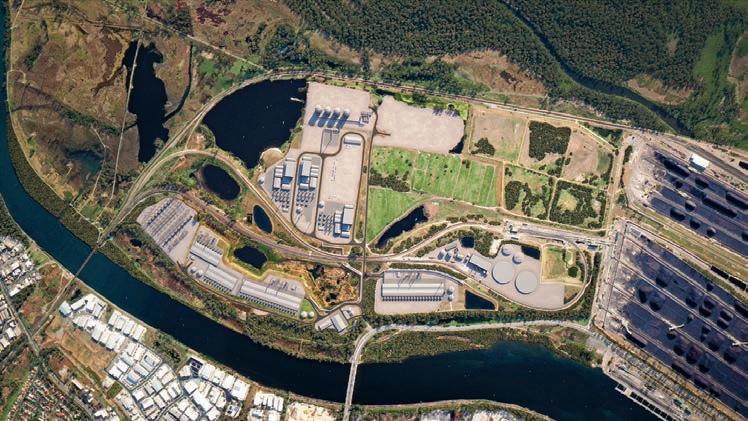
Frollouts and building electrification mandates, the New South Wales Government and councils are pushing forward on multiple fronts.
A centrepiece of the state’s energy shift is the newly approved Valley of the Winds wind farm near Coolah, in the Central-West Orana Renewable Energy Zone. Backed by a $1.68 billion investment from ACEN Australia, the project will feature 131 wind turbines and a 320 megawatt (MW)/640 megawatt-hour (MWh) battery, generating enough electricity to power over half a million homes annually.
Approved by the NSW Independent Planning Commission (IPC) in June, the 943MW project will be one of the largest in the state, with construction to span 42 months. Environmental conditions attached to the approval include biodiversity offsets, turbine height restrictions, screening for nearby residents, and a long-term decommissioning and rehabilitation plan.
Despite more than 50 objections, including from the local council, the IPC deemed the project vital to the state’s net zero goals. It also acknowledged the cumulative impacts on the region, where multiple renewable projects are underway, and required a $24.8 million Voluntary Planning Agreement to support community infrastructure.
In June, the NSW Government committed $115.5 million to create a dedicated clean energy logistics hub at the Port of Newcastle.
Intertrade site, giving renewable energy projects a direct link between portside storage and Renewable Energy Zones across the state. The site will offer hardstand areas for oversize loads, upgraded freight access, and reduced congestion at key infrastructure nodes. EnergyCo and the Port of Newcastle are jointly managing the project, which is currently undergoing environmental assessment.
Meanwhile, clean transport remains a parallel priority. In late May, the government announced a $41.2 million expansion of fast and ultra-fast EV chargers, aiming to cut emissions from road transport and reduce barriers to EV uptake.
The initiative, which combines $16.1 million in public grants with private investment from BP, Tesla, NRMA and others, will see 246 chargers installed across 38 locations, including Sydney, Parramatta, Dubbo and Jindabyne. Each site will feature high-speed chargers capable of replenishing most EV batteries within 15 minutes and will be powered entirely by renewable energy. Accessibility features, such as pull-through bays and disability access, have been incorporated to ensure broad usability.
“These charging stations will make it easier to charge EVs away from home, while also helping to reduce climate pollution,” said Minister for Climate Change and Energy Penny Sharpe.
More recently, the focus has shifted to denser urban areas. In July, the Minns Government awarded $5 million in co-funding to five private charge point operators to install more than 500 kerbside
EV chargers across 130 suburbs. The grants, part of the state’s $10 million EV Kerbside Charging Fund, aim to address a major gap: EV access for residents without driveways or garages.
New sites will be prioritised in highdensity zones such as the Inner West, Newcastle and Parramatta, where apartment living is prevalent. Around 30 per cent of NSW drivers lack off-street parking, making kerbside charging vital for equitable access.
The chargers, ranging from 7 kilowatts (kW) to 22kW, must be publicly accessible 24/7, source electricity from renewables, and meet strict uptime and maintenance standards. Acting Minister for Climate Change and Energy Paul Scully described the rollout as “bringing us closer to a cleaner, more affordable transport future.”
Building better
Beyond transport and generation, policy shifts are also reshaping how buildings in NSW are designed. In late June, the City of Sydney announced it will mandate allelectric residential buildings from January 2026, with commercial buildings and hotels to follow in 2027.
The first phase of the policy will require new homes to use electric cooktops, ovens and heaters. A second stage proposes extending this to outdoor appliances and larger non-residential buildings. The change aligns with the NSW Government’s Sustainability SEPP, though the state has yet to mandate all-electric buildings at a wider level.
Lord Mayor Clover Moore said the move is imperative, as “relying on fossil fuel gas is bad for the planet, bad for our finances and bad for our health.”
Electrification advocates, including Solar Citizens, have praised the shift, noting that fully electric homes powered by rooftop solar can save residents hundreds annually while reducing emissions. The group has criticised the state government for lagging behind councils in requiring clean energy features in new builds, pointing to the 2024 Net Zero Commission report which found the built environment is still falling short.
Victoria’s renewable energy sector is undergoing a major shift, with state-led reforms and investments reshaping how clean energy is produced, stored and delivered.
The 100 Neighbourhood Batteries Program has entered its third phase, with $6.6 million in new funding to install at least 10 more community-scale batteries. This builds on the program’s earlier $10.92 million investment, which has so far delivered 90 batteries across 85 towns since 2023.
The program, led by the Department of Energy, Environment and Climate Action (DEECA), funds stationary chemical batteries ranging from 20 kilowatts (kW)/40 kilowatt-hours (kWh) to 5MW/20MWh. Grants of up to $400,000 per battery are available, with co-contributions encouraged. Applications are open until 15 September 2025 and projects must be completed by 31 August 2027.
Round three targets nine Local Government Areas that missed out in earlier rounds, including Casey, Wyndham and Moonee Valley. It also prioritises installations in constrained parts of the grid, areas with high outage risk, and for households unable to install rooftop solar.
Proposals are assessed on technical feasibility, safety, financial value and community benefit. Behind-the-meter systems must pair with solar PV and provide detailed energy modelling.
“Neighbourhood batteries return power into the hands of local communities,” said Energy Minister Lily D’Ambrosio. Acting Premier Ben Carroll added the rollout would help drive down energy bills with cheaper, cleaner electricity.
Gippsland offshore wind clears key approval
Off the coast of Gippsland, Iberdrola Australia’s Aurora Green Offshore Wind Project has cleared a major regulatory hurdle. The Offshore Infrastructure Regulator has approved the project’s feasibility-stage Management Plan, allowing site studies to begin.
The proposed wind farm is located over
25 kilometres off Ninety Mile Beach and is expected to deliver up to three gigawatts (GW) of power – enough for around 2.25 million homes. The first 1GW stage is anticipated to be operational by 2032, subject to further approvals.
From mid-July 2025, Iberdrola will deploy three oceanographic instruments to collect metocean data over 12 months. These include a FLiDAR buoy to measure wind profiles and weather conditions, a wave buoy, and a seabed frame to monitor currents and water quality. Equipment locations have been chosen to minimise impacts on commercial fishing.
“These activities are safe, responsible and aligned with the expectations of the regulatory framework,” said Iberdrola Australia CEO Ross Rolfe AO.
State Electricity Commission begins retailing clean energy
Victoria’s revived State Electricity Commission (SEC) began supplying 100 per cent renewable electricity to over 4000 public sites from 1 July 2025. These include schools, hospitals, traffic signals, transport networks and Docklands Studios Melbourne.
Electricity is sourced from the SEC’s own renewable generation and Victorian Renewable Energy Auction projects like Berrybank and Dundonnell wind farms, and solar hubs at Cohuna, Winton and Bulgana.
The move marks the SEC’s return to retail energy, servicing around five per cent of the state’s electricity market. Later in 2025, it plans to expand services to commercial and industrial customers with a focus on medium and large businesses.
The SEC will also offer demand management and behind-the-meter solutions to help businesses lower energy use and emissions.
“This gives us a strong base to expand our offering so Victorian businesses can transition to renewables and meet their carbon goals,” said SEC CEO Chris Miller.
Docklands Studios Melbourne Chair
Louisa Coppel said the clean supply supports the studio’s sustainability credentials and boosts its global competitiveness. Minister for Creative Industries Colin Brooks agreed, saying the move strengthens Victoria’s position as a sustainable screen production hub.
VicGrid gains full planning authority
At a system level, the state has introduced a bill to hand full control of transmission planning and Renewable Energy Zone (REZ) delivery to VicGrid. The National Electricity (Victoria) Amendment (VicGrid Stage Two Reform) Bill 2025 shifts powers from the Australian Energy Market Operator to VicGrid.
The legislation enables VicGrid to implement the 2025 Victorian Transmission Plan, manage access to the grid, issue new developer approvals, and plan and deliver major transmission projects.
It also introduces new community benefit mechanisms. Developers will now pay access fees, which will fund REZ Community Energy Funds and a Traditional Owners Fund. A formal payment of $8000 per kilometre of hosted infrastructure will also go to affected landholders.
VicGrid is authorised to enter land for investigations, run REZ tenders, and carry out early works on network upgrades. Its powers now include information gathering, land access, and fee-setting – functions previously held by AEMO.
“These reforms will ensure industry has the certainty to invest and VicGrid can do the important planning that keeps the lights on and delivers cheap renewable power,” said Minister D’Ambrosio.
Together, these developments signal a shift toward a more coordinated, community-centred renewable energy system, with the state taking an increasingly hands-on role in both delivery and oversight.
Battery storage is booming and local manufacturing is ramping up in Western Australia, but new generation capacity remains a pressing need.
The main power network in Western Australia, the South West Interconnected System (SWIS), is becoming more reliant on batteries. More than 500 megawatts (MW) of grid-scale storage has come online since 2023, with another 728 MW committed for delivery in 2025–26.
While these batteries are helping to smooth daily peaks and support short-term resilience, the Australian Energy Market Operator (AEMO) has warned that storage alone cannot meet future demand.
In its latest 2025 Wholesale Electricity Market Electricity Statement of Opportunities (WEM ESOO), AEMO forecasts a growing shortfall in dispatchable generation. Without new firm supply, the SWIS could face a deficit of more than 900 MW by 2027–28. Even under best-case conditions, a 50 MW shortfall is expected as early as the 2025–26 summer.
AEMO’s modelling highlights a key issue: batteries, while increasingly abundant, typically offer four hours of discharge –insufficient for evening peaks that now stretch well beyond sunset. In response, AEMO has raised the benchmark for new batteries to six-hour durations.
To stabilise the system, AEMO says at least 110 MW of new energy-producing capacity must be secured by 2027–28. So far, most proposals focus on storage, not generation. More than 2.3 gigawatts (GW) of new capacity was flagged through expressions of interest this year, but little of it will deliver the firm output needed for sustained reliability.
Complicating the picture further are grid constraints. Western Power’s Clean Energy Link-North (CEL-North) and East
Enhancements projects are designed to unlock renewable potential in the Mid-West and Goldfields. Delays to either project could exacerbate regional shortfalls, particularly in the Eastern Goldfields and North Country. AEMO’s current outlook already assumes a one-year delay for CEL-North.
Meanwhile, WA’s rooftop solar boom is lowering minimum daytime demand and increasing system variability. This puts more pressure on flexible technologies like synchronous condensers and grid-forming inverters, which can stabilise voltage and frequency when traditional generators are offline.
Targeted investments in batteries and manufacturing
In response to these pressures, the WA Government has made several targeted investments to strengthen local supply chains and bolster battery uptake.
The 2025–26 WA Budget includes $50 million for a new Local Battery Manufacturing Program. Of that, $30 million will go toward grants (up to $10 million per project) to support local firms producing residential-scale batteries. A further $20 million will be available through low-interest loans and land incentives.
This initiative aims to build on the state’s $337 million Residential Battery Scheme and the Commonwealth’s Cheaper Home Batteries Program. Together, these schemes are expected to help 100,000 households store rooftop solar and reduce their reliance on the grid.
Eligible households can already access rebates – up to $5000 for Synergy customers and $7500 for those in Horizon Power areas. There was little in the Budget to support new utility-scale renewable energy or storage projects beyond those
already announced.
The State Budget also introduced a $20 million package to stimulate local manufacturing of transmission infrastructure. This includes funding to develop two advanced manufacturing hubs – one in Forrestfield and one in Picton – that will produce steel components for powerlines and substations. These hubs are intended to supply the growing needs of Western Power as it upgrades the grid to support renewables.
The Forrestfield site, backed by a $10 million investment, will be developed in partnership with established steel fabricators. The Picton hub will receive $5 million through the Strategic Industries Fund. Both sites will benefit from Western Power’s procurement pipeline, and their development aligns with the government’s “Made in WA” strategy to onshore critical supply chains.
An additional $10 million has also been allocated to the Local Industry Development Fund to promote local content across government procurement, particularly in energy infrastructure projects.
To help steer this complex energy transition, Western Power has appointed former Under Treasurer Michael Barnes as its new Deputy Chair. Barnes, who served as WA’s top fiscal official for over a decade, is expected to bring a sharp focus on economic governance and investment oversight.
His appointment follows the departure of long-serving board member Eva Skira, and comes as Western Power’s role becomes more central to WA’s decarbonisation strategy. From integrating large-scale renewables to facilitating the electrification of transport and industry, the utility’s network is the backbone of the transition.
Stringing optical ground wire over live 500-kilovolt lines had never been done in Australia.
Australia’s transmission sector hit a new milestone recently, with the Lines team at Consolidated Power Projects Australia Pty Ltd (CPP) completing a first-of-its-kind operation: the stringing of optical ground wire (OPGW) over live 500kV (kilovolt) circuits.
Replacing shield wire while keeping the system energised is difficult under any conditions, but doing so across live transmission lines, freeways and rail corridors ratchets the challenge to a national first.
“This wasn’t just a technical step forward. It’s a fundamental shift in how we think about executing major works on critical infrastructure,” says Sean Dunn, General Manager of Transmission Lines at CPP.
The operation significantly reduced the outage time for client AusNet, reflecting not only the team’s precision but the growing need for flexible, low-disruption methodologies in Australia’s tightly balanced grid.
An ambitious step
While CPP had previously completed live OPGW works on a double circuit 220kV line, the 500kV project marked a significant leap in complexity.
“The electrical induction is so much higher at 500kV,” explains CPP’s Wade Pihama-Bishop, the construction supervisor for CPP’s first non-outage OPGW replacement on the live 220kV double circuit line.
“Working on or close to live circuits induces an electrical current in OPGW and non-energised conductors. Even if you’re not touching the live 500kV conductor, you can still get zapped – or worse – just by getting too close.”
“Induction is invisible, unpredictable and deadly,” Dunn said.
“It’s absolutely a critical risk that needs to be mitigated. Induction, working over live conductors, and complicated crossings all required specific work methods and controls to keep workers safe. It’s complicated. That’s
why no one had strung OPGW over live 500kV before.”
To mitigate the danger, CPP deployed a comprehensive control framework, underpinned by Safe Approach Distances (SADs) and what Dunn calls “the capacity to fail safely”, based on CPP’s safety program ‘The Capacity Model’.
“We don’t just plan controls for hazards. We plan for what happens if the control fails. Will someone get hurt? If yes, then it’s not safe. It’s about engineering that margin for error, even if no one ever intends to make one,” he says.
Engineering the impossible
At the heart of the method is a concept called cradle blocking: a length of dielectric rope threaded across spans with cradle blocks at 7–10 metre intervals that acts as a safety net beneath the OPGW as it’s pulled.
wire,” Pihama-Bishop explains.
“But if something breaks or slips, that wire can’t fall. The cradle blocks catch it before it can touch anything live or fall to ground.”
To further manage induction, the team used stringing rollers with grounding arms installed, along with other proprietary gear. Drones were also used to run ropes between towers, avoiding the need to place a robot on lines where the weight would have increased risk. Another important element was the use of the latest technology in stringing gear that allowed the tension in the OPGW to be finely controlled throughout the pull.
The work required navigating high-traffic corridors, including the Western Freeway and Melbourne to Ballarat railway – both of which remained operational during works.
CPP site manager Kurtis Allum says the pre-approvals alone took months.
“Just getting the traffic management plan
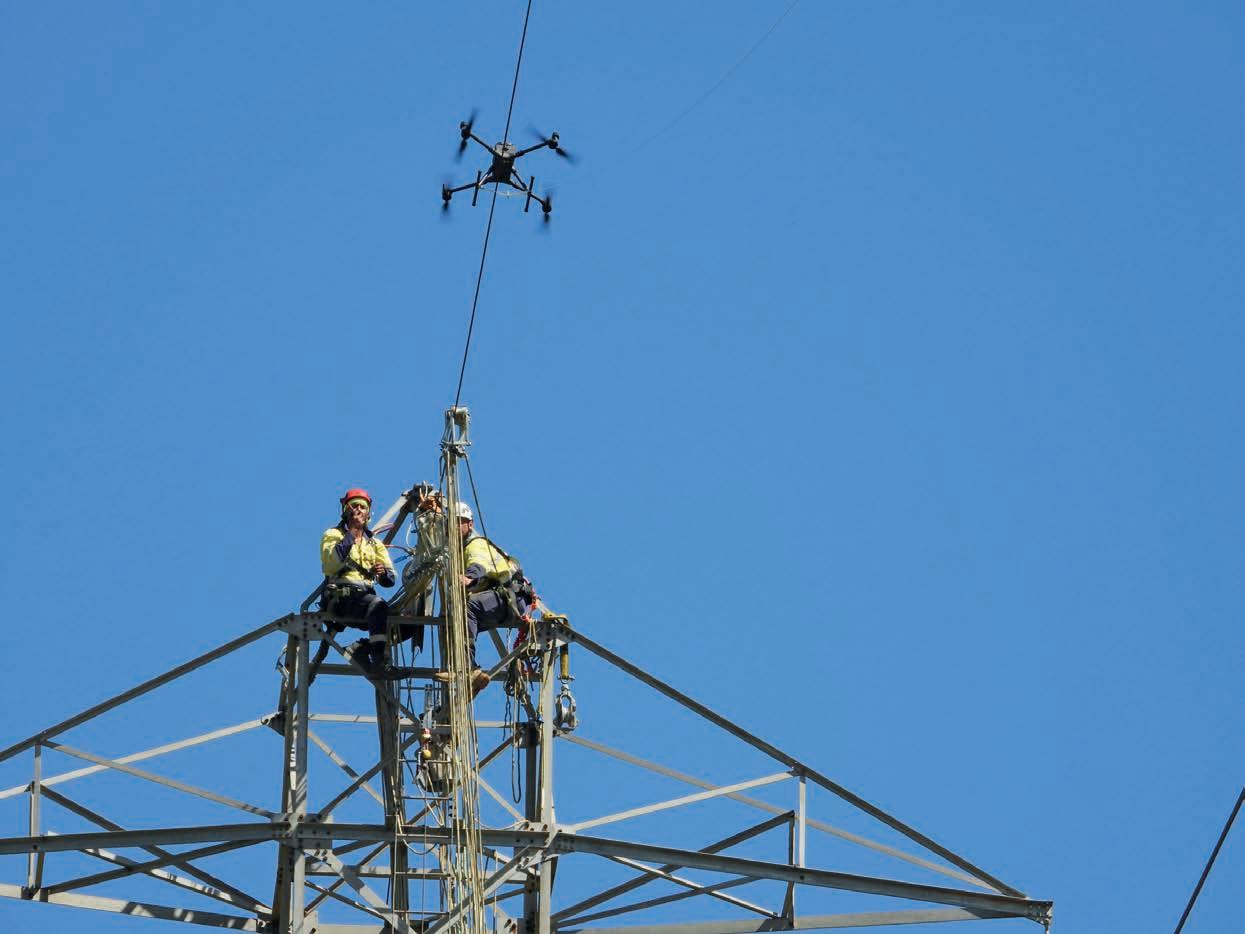
“You’re proving every methodology to stakeholders, from road authorities to rail operators. You can’t afford to leave any doubt in their mind.”
Training, trust and terrain
Beyond technology, it was the crew’s readiness that made the job viable.
“We can’t do jobs like this without the field crews and crew leaders. They’re up there with the induction, the wind, the height… and still need to be precise,” says Allum.
Pihama-Bishop says that many of the team had to upskill for live-line work.
“We brought in barehanders – guys used to working live – but for others, it was their first exposure to this level of complexity. It’s a big deal. These projects are going on their résumés for good reason,” he says.
Dunn agrees.
“At times, you’ve got team members five kilometres apart coordinating movements. One misstep and you can snap a line or worse. So communication and crew culture is everything. We had full-team stand-downs to review safety whenever needed. The operators have the authority to stop work if they’re not comfortable. And they do,” he says.
That culture, Allum says, extends beyond the site.
motto. Barbecues, debriefs and group dinners –they’re not perks. They’re part of building trust,” he says.
Three years, four firsts CPP’s lines division is just three years old, but it’s already notched up several national firsts.
After being restructured under new ownership, the team quickly grew from a two-state operation into a 50-strong national outfit.
In that time, it completed the first dualcircuit 500kV cut-in, followed by the 220kV live OPGW project, then the 500kV version, and more recently, a world-first 500kV conductor transfer – executed live.
This sequence of high-voltage milestones showcased not only technical proficiency, but a growing capability to execute under increasingly complex, live conditions.
“Many of the team brought significant industry experience to CPP, including our Construction Manager, Walter Fiedler, with over 45 years in the trade,” says Dunn.
“In the first year, we had maybe a dozen guys. Now we’re at 50. It’s not just about size, but capability,” says Pihama-Bishop.
“You cross paths with these blokes in 20 years and say, ‘Remember when we did that first 500kV job?’ That’s legacy stuff.”
Every time work can be undertaken without a scheduled outage, it carries significant value for the asset owner.
However, the real value goes beyond time.
“Avoiding outages reduces strain on the
Setting the standard
With CPP’s work drawing attention across the sector, Dunn notes a cautious optimism.
“Our clients have seen what’s possible, and that’s great. But there’s a risk if others try to replicate it without the same competency, planning or safety culture,” he says.
“You can’t just reverse-engineer this. It takes years of experience to know what the real risks are – and how to fail safely if something goes wrong.”
Looking ahead, the team is already planning another first-of-its-kind job. While details are still under wraps, it involves replacing entire towers without de-energising the conductors on a voltage and tower type never done before.
The pride and the payoff
Despite the scale and stress of the job, morale remains high. According to Allum, it comes down to shared pride and purpose.
“There’s real satisfaction in knowing we’ve done something new, something that made a difference. And we did it together. That stays with you,” he says.
Dunn takes great pride in the work, even with the risks involved.
“I think we work in the best industry in the world,” he says.

In an industry defined by transitions – technological, environmental, and geopolitical –Specialised Energy Solutions (SES) is gaining a reputation not just for adapting to change, but for leading it by consistently meeting and exceeding the evolving needs of its clients.

Aaron Mulhall, General Manager and Founder of Specialised Energy Solutions (SES), is at the centre of a company driving Australia’s energy transition. His focus on precise execution, transparent accountability, and deep technical expertise has propelled SES from a nimble startup to a leading force in Australia’s utility-scale renewable energy infrastructure sector.
“We’re not here to win every tender, we’re here to deliver exceptional results on the ones we choose to pursue. For us, it’s about building long-term partnerships,” says Mulhall.
“Clients come to us because we fix what others walk away from – and we deliver solutions that last.”
SES launched in 2022, but Mulhall’s own career runs more than 15 years deep into Australia’s electrical and infrastructure
sectors. He says that what sets SES apart is its field-proven expertise in understanding how systems perform under real-world operational stress – not just in theory.
Coupled with a strong commitment to quality, clear communication, and customised delivery, SES has earned the trust of Tier 1 clients and secured long-term partnerships.
Spend enough time in internal meetings, the company says, and someone will inevitably refer to themselves as a “nomad” – a reflection of the SES culture, where teams move from project to project, often in some of the most remote and challenging locations. At SES, everything happens in the field. Being on site is not just part of the job – it defines the company.
“SES was built around a simple but powerful premise,” Aaron explains.
“What if your EPC partner didn’t just build the system – what if they understood it inside out, could operate it, and were ready to repair or upgrade it the moment something went wrong?”
“That’s the depth of expertise we bring. We’ve commissioned the equipment, repaired it, and redesigned it when necessary. We also maintain strong, ongoing relationships with many of the leading renewable equipment manufacturers.”
With over 6.9 gigawatts (GW) of project experience spanning solar, battery storage, substations, and hybrid solutions – including major developments across NSW, QLD, SA, WA, and the ACT – SES has established itself as a trusted delivery partner.
SES also provides comprehensive Operations & Maintenance (O&M) services, ensuring lasting performance and

accountability beyond project completion.
“We’ve operated at scale across every major state, often in challenging conditions,” says Mulhall.
“We don’t just deliver infrastructure – we actively absorb risk on behalf of our clients. This is made possible by our rigorous staff selection process and a team of highly qualified, experienced professionals in the field.”
Redefining EPC from the inside
In a sector often split between glossy front-end consultants and reactive service providers, SES has consciously embedded full-cycle capability into its model, from early works through to long-term maintenance.
“This isn’t just about vertical integration,” says Mulhall, “it’s about accountability.”
By uniting EPC, commissioning, storage
and logistics, and long-term O&M under one roof, SES removes the disconnects and handovers that often result in performance losses and diminished asset reliability.
This integrated approach ensures end-to-end ownership and consistently high-quality outcomes.
“Plenty of companies can sell EPC,” Mulhall says.
“But if you’re going to install 100 megawatts [MW] of batteries, someone’s got to make sure they don’t trip in year two. We make those decisions upfront because we’re the same team answering the phone when the inverter’s down.”
SES’s EPC expertise spans small to medium-scale projects, typically ranging from 2 to 50 MW, while its Construction and Commissioning (C&C) division has played a role in delivering over five GW of
installations across the nation.
From underground high-voltage cable installations, to specialist busbar mounting and noise suppression retrofits, SES integrates advanced field expertise with electrical services and comprehensive project management.
Its ISO 9001, 14001, and 45001 certifications demonstrate a commitment to procedural discipline and are a testament to the company’s externally verified operational rigor.
One of SES’s most valuable yet often under-recognised capabilities is its technical forensics team. The team provides independent root cause analysis (RCA) for major failures across PV, battery energy storage systems (BESS), and electrical balance-of-plant (BoP) infrastructure.
“There’s a significant service gap in this area,” says Alba Ruiz Leon, Non-Executive Director at SES.
“The industry urgently needs unbiased technical reporting on behalf of asset owners. When failure assessments are conducted by manufacturers, there’s an inherent risk of bias.
Independent RCAs are essential – they serve as critical technical evidence for insurance claims, support clients in securing manufacturer replacements at no additional cost and help identify potential equipment serial defects.
“When a solar asset underperforms or a transformer fails, clients need more than technicians who simply replace parts – they need a trusted partner with highly qualified experts capable of precise diagnosis,” Ruiz Leon explains.
“That’s what sets SES apart. We’re the partner clients turn to when they require faults to be fully resolved – not just identified or temporarily patched. We take the time to clearly communicate the risks and benefits of the available options, empowering clients to choose the most appropriate long-term solution for their business.”
SES performs thorough investigations to uncover root causes and functional failures, delivering repairs that ensure sustained asset reliability and peak performance.
This hands-on expertise directly informs SES’s comprehensive O&M model, which integrates predictive, preventive, and corrective maintenance with flexible, bootson-the-ground support for PV, BESS, and hybrid sites – delivered by mobile or fixed, HV-qualified teams.
The outcome is fewer unplanned outages, extended asset lifespan, and significant cost savings over the mid to long term. These benefits are especially critical in markets facing tight margins and increased regulatory scrutiny.
“As we hear consistently from our clients, the market is urgently demanding highquality O&M service providers,” Mulhall adds.
#theSESstandard
Mulhall is no fan of hollow slogans, but he does believe SES’s culture is its differentiator. The company operates under what it calls ‘#theSESstandard’ – a
our clients demand,” says Mulhall.
“Our teams are cross-trained across solar, wind, BESS, and grid-side infrastructure –including substations and balance-of-plant systems – because in remote environments, you don’t get second chances.”
“Versatility and precision in the field are critical to delivering reliable results under pressure.”
Asked about the future of the sector, Mulhall does not point to technology alone. Instead, he highlights changing client expectations and regulatory environments
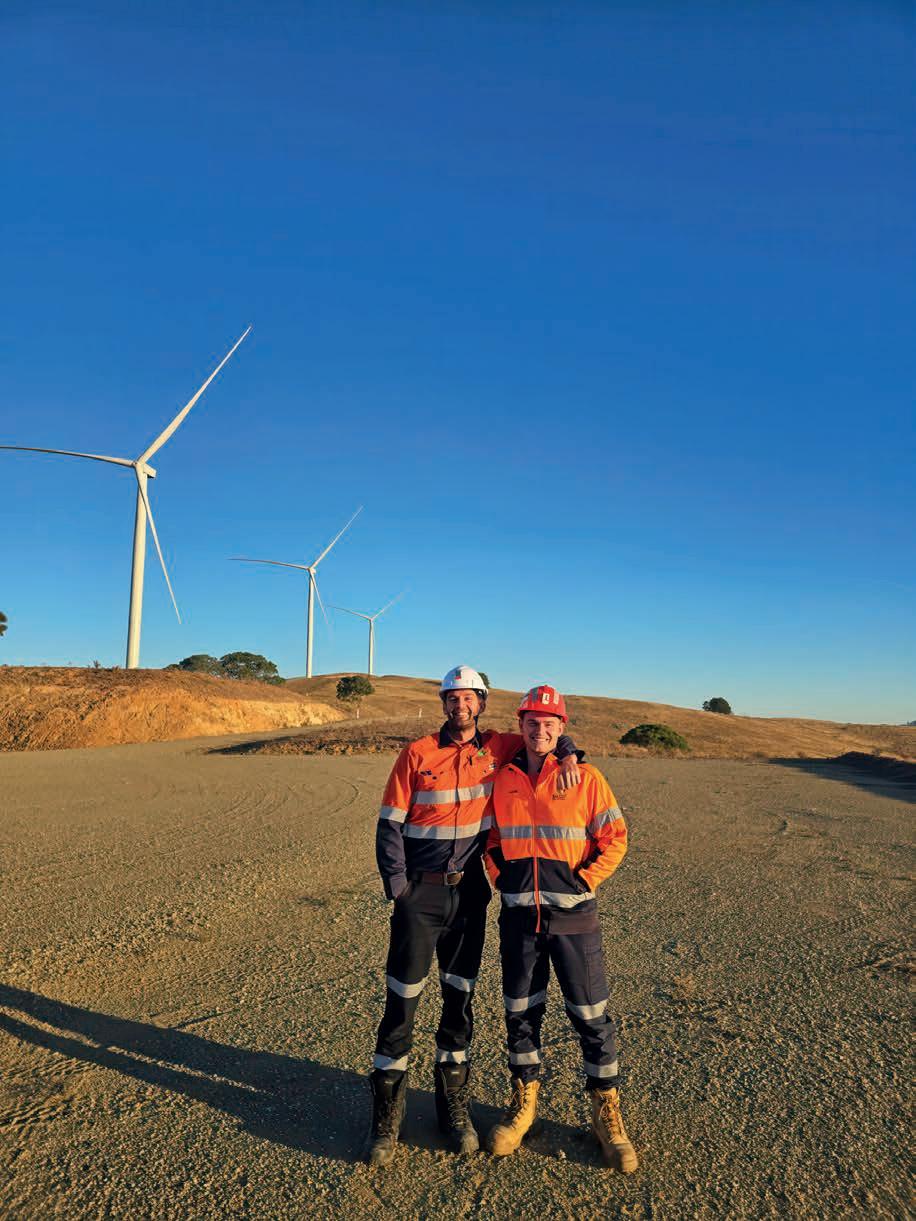
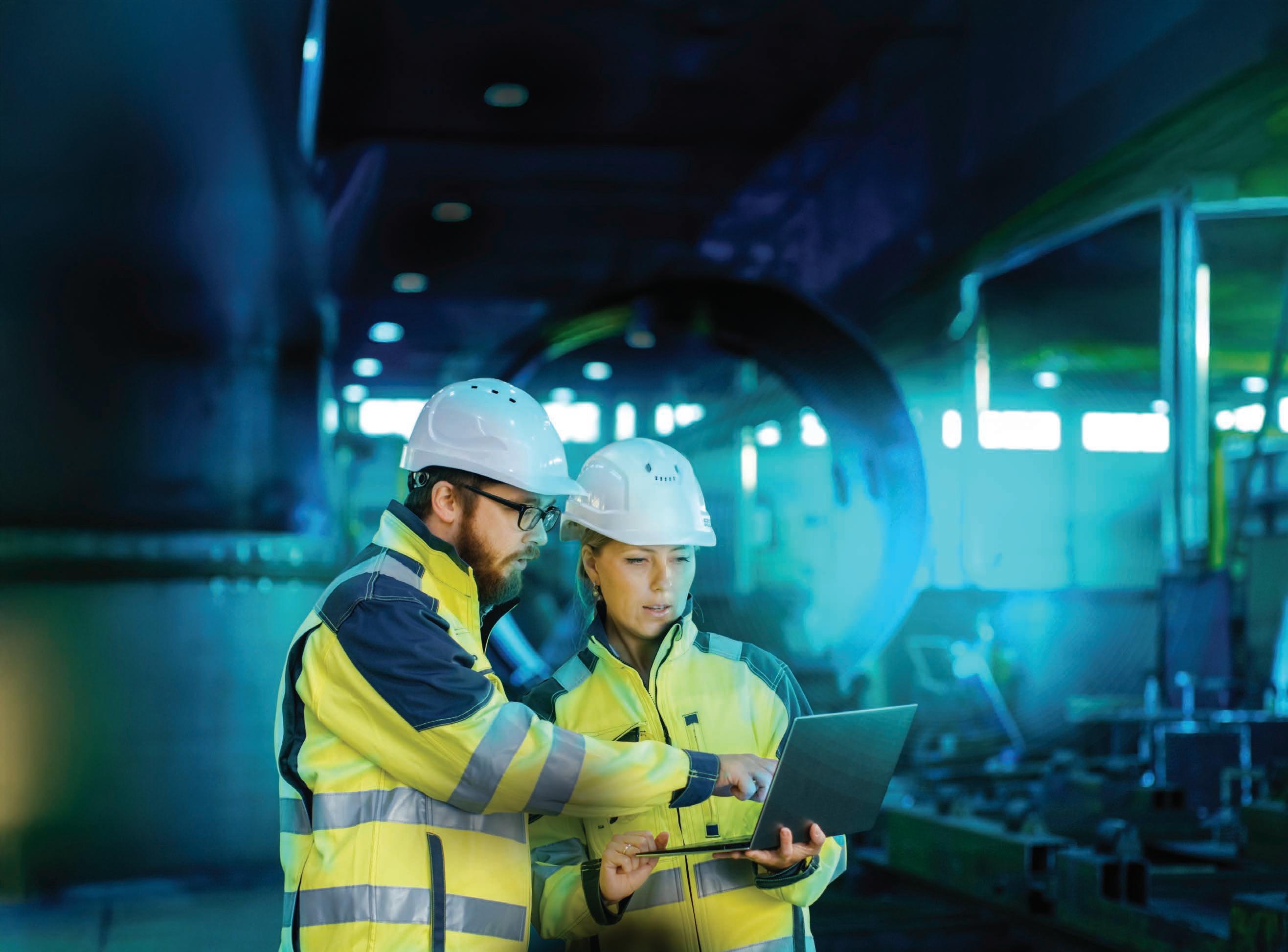

Converge Expo brings together industry leaders across the municipal, civil and commercial construction sectors who are change makers shaping Australia’s future infrastructure.
17–18 SEPTEMBER 2025 Melbourne Convention & Exhibition Centre Australia’s hub for civil, commercial, and municipal solutions
A new Australian-made solar framing system is turning heads not just for its engineering, but also for its low-carbon footprint and circular economy credentials.
Solar Waves is a utility-scale solar deployment innovation developed by Sydney-based clean-tech company Green Energy Systems (GES).
This patented, prefabricated solution scraps traditional solar racking hardware like nuts, bolts, screws, or clamps, in favour of interlocking aluminium profiles that snap together.
The system is made entirely from Capral Aluminium’s low-carbon LocAl™ Green aluminium, delivering a streamlined, recyclable structure designed for automation.
GES founder and CEO Glenn Carless says the innovation was born from necessity and a willingness to re-imagine solar.
“We immediately recognised that by combining the PV panel frame with the racking system, we could produce something that was stronger, lighter, cheaper – and that formed an entire waterproof roof,” Carless says.
“Traditional fixings are a barrier to automation. Robots don’t like dexterous tasks like tightening bolts. We had to eliminate them to make full factory automation possible.”
That vision is now being realised. Solar
Waves is the chosen technology for Project Nexus in California, a landmark trial to cover thousands of miles of irrigation canals with solar panels.
The pilot, led by Solar AquaGrid, has the potential to generate 20 gigawatts of solar power and prevent billions of litres of water loss through evaporation.
GES’s role is pivotal.
“They’d spent two years and $20 million looking for a viable solution,” Carless says.
“We’re delivering a plug-and-play system that arrives fully prewired, preassembled and ready to roll out. You connect the plug at one end, and that’s it.”
“It’s a complete solar appliance.”
Aluminium reinvented
Key to this breakthrough is Capral’s LocAl™ Green aluminium – locally extruded aluminium sourced from primary aluminium smelters using alternative energy sources. Its embodied carbon is capped at eight kilograms of carbon dioxide equivalent per kilogram (kg CO₂e/kg), with an even lower ‘Super Green’ option, also available with a maximum of just 4kg CO₂e/kg.
“LocAl is our response to the growing
demand for materials with lower embodied emissions,” says Leanne Cannarella, Industrial Account Manager at Capral.
“Solar developers like Glenn build their entire business on sustainability. It only makes sense that the materials match that ethos.”
Unlike traditional aluminium, which in Australia can average up to 20kg CO₂e/kg due to coal-based smelting, LocAl is part of Capral’s strategic shift to greener sourcing. Though currently imported, Capral is pushing for domestic production of lowcarbon billet by the end of the decade.
“We’re proud to be the first Australasian extruder certified to the ASI Performance and Chain of Custody standards,” Cannarella says.
“It means our LocAl aluminium is responsibly sourced, and emission verified.”
The Solar Waves system uses customdesigned Capral aluminium extrusions, engineered to fit together like modular components.
“One of the incredible benefits of aluminium is the ability to create highly detailed, intricate profiles,” says Cannarella.
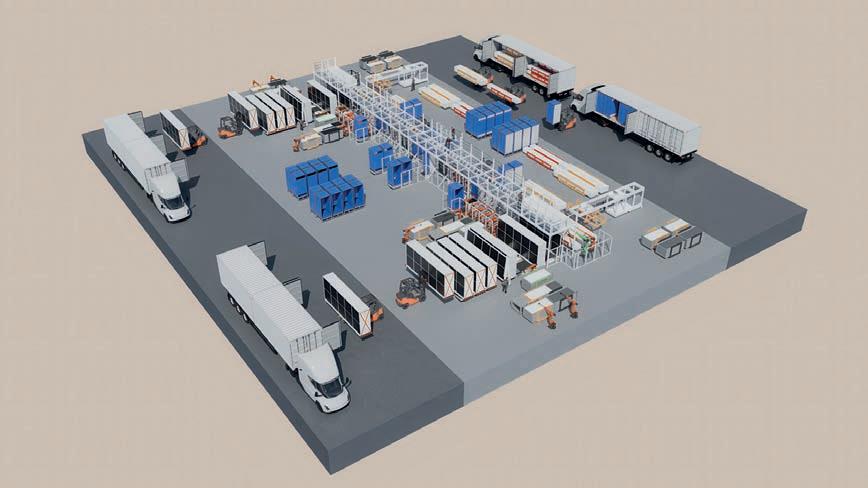
“That allows for snap fits and grooves, eliminating the need for mechanical fasteners.”
This combination of design detail and extrusion precision has allowed GES to halve the material content compared to traditional solar racking systems, while still achieving Category Five cyclone strength ratings.
“All we use is aluminium, nothing else,” says Carless.
“We’ve managed to make the system stronger than everybody else’s, even though we’re using about half the amount of material.
“The unique profiles slide and click into place. There are about 20 different components, and that’s it – no extra steel, no concrete.
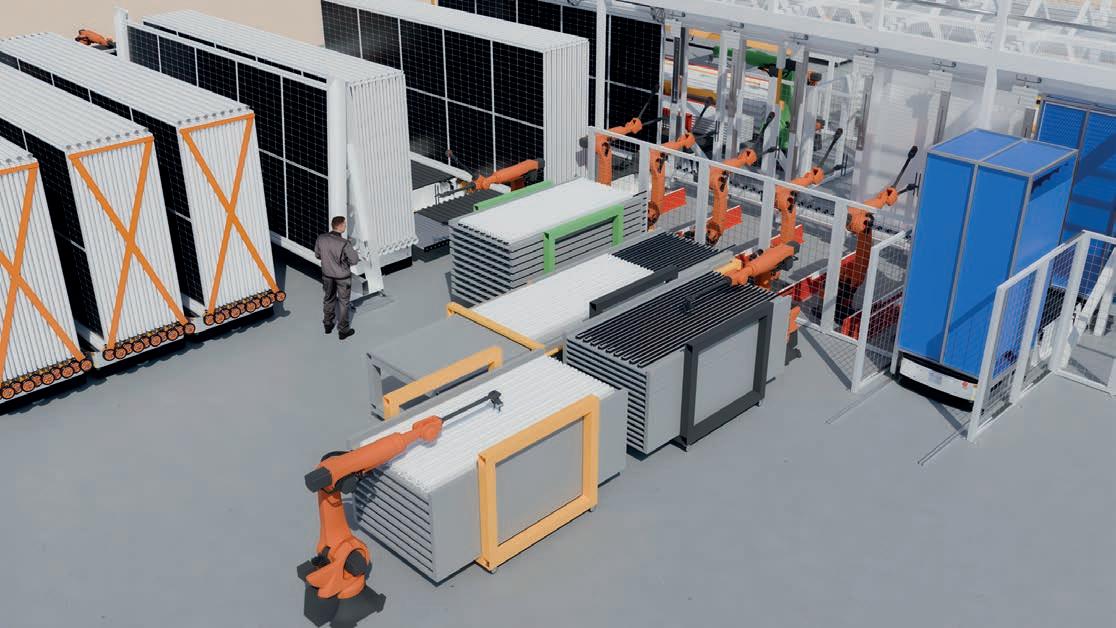
“Capral’s ability to produce tight tolerances was essential,” he says.
“We even solved a friction issue by adding micro-fluting to a ball-joint fitting, just to allow smooth robotic handling.”
The resulting modular units – dubbed ‘MegaWaves’ – can be deployed in hours, drastically reducing installation time and labour. GES estimates its in-factory assembly cost is just two cents per watt, compared to 20 to 30 cents using conventional methods.
From paddock to canal, via the vineyard
While most large-scale solar is destined for paddocks, GES has broader ambitions. Its technology is adaptable to rooftops, reservoirs, car parks, and even elevated agrivoltaic systems – where solar panels float above crops to provide shade and water protection.
“We’ve been approached by universities for trials over vineyards. Our panels form a waterproof roof that can collect and redirect rainwater,” Carless says.
“We use that water to irrigate or – and this is another big one – to clean the panels.”
The built-in cleaning system recycles rainwater through a small DC pump and internal jets along the panel ridge.
“Dirty panels can lose up to 30 per cent of their efficiency over time,” Carless says.
“Cleaning saves up to $1 million per megawatt over 30 years – and ours is the only system with an integrated solution.”
Australian collaboration with global impact
For Capral, supporting innovation in renewables is a deliberate strategy.
“We want to partner with companies like GES who are pushing sustainability forward,” Cannarella says.
“That’s why we’re in marine, transport, construction – and now renewables.”
GES’s first factory, currently in planning, is expected to produce 400 megawatts of Solar Waves systems annually – equivalent to $400 million in product.
“It’s not just a few window frames. This is large-scale manufacturing,” Carless says.
“And it’s local. Because our system uses less material, we can afford to buy Australian aluminium and still beat the rest on price.”
GES’s all-aluminium system is fully recyclable at end of life – a key contrast to rival technologies that rely on concrete, galvanised steel or complex composites.
“There’s no other utility-scale system that is 100 per cent recyclable,” says Carless.
“And because we’ve eliminated complexity, the second life of our panels will be even cheaper than the first.”
Capral is also working to boost circularity. It has signed agreements with Rio Tinto’s Boyne Smelter to remelt post-production scrap into billet with a minimum of 20 per cent recycled content. While barriers remain – especially in energy use and emissions at local smelters – the company is working with upstream suppliers to lift the share of recycled aluminium in its products.
Carless sees real potential for Australia to lead in low-carbon solar manufacturing, if automation is embraced.
“We can’t compete with Chinese wages, but we can with robots. If we fully automate, we can win on speed, quality, and cost,” he says.
“We don’t need people tightening bolts. We need technicians overseeing machines.”
Capral’s team agrees.
“Our job is to provide the materials, the design support, and the partnerships that make ideas like Solar Waves possible.”
This Australian collaboration could well signal a new frontier where clean energy, low-carbon materials and smart manufacturing come together, not just to compete, but to lead.

Landholders are finding themselves at the frontlines of renewable energy transformation.
While regional and remote properties are increasingly in demand for solar arrays, wind turbines and storage installations, many landholders are poorly equipped to understand the value and impact of hosting renewable infrastructure. This can make progress slow and frustrate both developers and landowners.
This is an information gap that RELA Australia is closing.
With the support of $500,000 in Federal funding through the Australian Renewable Energy Agency (ARENA), the marketplace platform is rolling out a significant upgrade to its land assessment software: Assess 2.0.
The tool offers free, independent desktop assessments of a parcel’s renewable energy

potential – data that can help landowners make informed decisions, protect core farm operations, and negotiate better outcomes when approached by developers.
The aim is not just to increase project uptake, but to rebalance power in negotiations and build lasting social licence for the energy transition.
“We’re neither developers nor landowners,” says RELA CEO Michael Katz.
“Our neutrality means we can be factbased. We don’t set the market – we provide landowners the facts, so they can engage on an equal footing.”
Self help avoids advisory bottleneck
The original version of the tool (Assess 1.0) offers useful insights but required RELA staff
to manually run reports on a landholder’s behalf. This makes the process resourceintensive and limits its reach.
With Assess 2.0, RELA is creating a fully self-service platform, enabling landowners or their advisors to input property details and receive an automated, data-driven report in minutes.
“It’s much faster and far more scalable,” says Stuart Gourley, RELA’s Chief Product Officer.
“We want it to be as easy as possible for landowners to get accurate, independent information about their land’s renewable energy potential.”
The desktop analysis draws on a wide range of geospatial and infrastructure data –vegetation cover, watercourses, topography,

grid proximity and capacity, and more – layered with new social licence indicators and advanced grid analysis.
Importantly, it now incorporates landholders’ own farm planning priorities, including infrastructure placement, exclusion zones and land-use preferences. This cuts time and friction in the later stages of the negotiation.
“They can run different scenarios,” Gourley says.
“What if I make this part of my farm available? What if I want certain infrastructure to be unaffected? They can consider those different scenarios, weigh up the cost-benefit analysis, and make informed decisions about how they want to balance their opportunity.”
Reducing asymmetry, building confidence
Katz likens the current imbalance to selling a used car without knowing its market value.
“We’ve seen landholders sign deals that were undervalued – and others with wildly inflated expectations. Our job isn’t to push prices up or down. It’s to provide clarity, so landowners understand market dynamics,” he says.
“Sometimes the opportunity is to actually create value on your farm through these projects as well. One of our first clients said, ‘A road in the right place is an asset and a road in the wrong place is a liability.’”
That imbalance is not just financial. Farmers are experts in producing food and fibre, but not renewable energy projects.
An imbalanced market can erode trust, sour negotiations and slow project rollouts – problems the 2023 Dyer Community Engagement Review identified as key obstacles to Australia’s clean energy ambitions.
“The misconception is that if you’re a good negotiator and a good businessperson and you know the land, then you’re ready to negotiate a wind farm,” says Katz.
“But it’s a highly esoteric, complex negotiation. You need a good team around you – not just RELA, but also the right lawyers and financial advisors.”
The upgraded RELA Assess tool will not provide legal advice or guarantee outcomes, but it does give landholders a clear sense of whether their land is viable, what it might be worth in a renewables context, and how different land-use scenarios affect its potential.
Users receive estimates in terms of dollars per megawatt or turbine, indicative
net present value of rental streams, and contextual grid data – all explained in plain language.
That transparency has another benefit: it helps reduce friction between landowners and developers.
As Gourley says, “We’re supportive of good projects and balanced outcomes. We want to help both sides get to agreement faster, based on a shared understanding of the facts.”
One of the most distinctive features of the Assess 2.0 project is how it is being shaped. From the beginning, RELA has embedded a Stakeholder Reference Group (SRG) into the product’s development process. The group includes farmers, landholder advisors, agricultural peak bodies, First Nations representatives, as well as government and industry stakeholders.
It’s not just consultation for consultation’s sake, says Katz.
“There’s a saying I’ve heard from a lot of people in the regions: we’re over-consulted but under-engaged,” he says.
“People say, ‘What do you reckon?’ and then ignore it. What’s powerful here is that their perspectives of market participants are being represented in real tools being built for their people and implemented to market.
“Every SRG recommendation is formally tracked, responded to, and, where feasible, implemented. If it’s not feasible and in scope for this project, we’re considering how it could be implemented in the future. There’s a direct line from community and stakeholder insights to the product we’re releasing.”
That emphasis on co-design extends to how the tool supports First Nations perspectives and traditional land uses. While still in development, these features will be refined in future iterations with SRG guidance.
RELA’s independence is core to its credibility. The company does not own land or develop energy projects, and it is not a party to the transaction itself. Assess 2.0 is free for landowners and strictly private. Users control their own data and no third parties can access or infer which properties have been assessed.
“We don’t have a position on energy policy or politics,” says Katz.
“Our view is that farmers should have
access to the facts and data they need to make informed decisions, and that’s the role we play.”
Gourley says RELA has no plans to sell user data or allow backdoor access. The information is for the landowner and their advisors to use.
For landholders unable or unwilling to use the tool directly – whether due to limited digital literacy, connectivity, or preference – RELA will continue to offer staff-run assessments as in version 1.0. Advisors and agents will also be able to use the tool on a client’s behalf, further extending its reach.
While the Assess platform is independent, it aligns closely with national policy trends.
The Federal Government’s upcoming Developer Rating Scheme – designed to increase transparency and trust in renewable project proponents – shares the same goals of fairer deals and informed engagement.
RELA’s tool does not assess or rate developers, but it gives landowners the foundational knowledge to interact with them from a position of strength.
The work also aligns with ARENA’s emphasis on social licence and landholder inclusion as preconditions for energy transition success.
According to Katz, RELA was able to demonstrate not only alignment with ARENA’s goals, but real-world outcomes: stalled projects that progressed after landholders used RELA tools to clarify their terms and conditions.
“Technology alone won’t get us to net zero,” he says.
“We need a social model that respects landholders’ knowledge, protects their operations, and shares the benefits.”
RELA plans to expand Assess to support battery storage assessments, and ways to integrate carbon and biodiversity offset opportunities, which are increasingly linked to renewables projects and offering landholders additional revenue streams.
“This isn’t just about helping farmers get a better deal,” Katz says.
“It’s about enabling regional Australia to take an active, informed, and equitable role in shaping the future of energy.”
The platform will remain free for landholders to access and use.
RELA’s expanded Assess platform is due to launch in the first quarter of 2026.
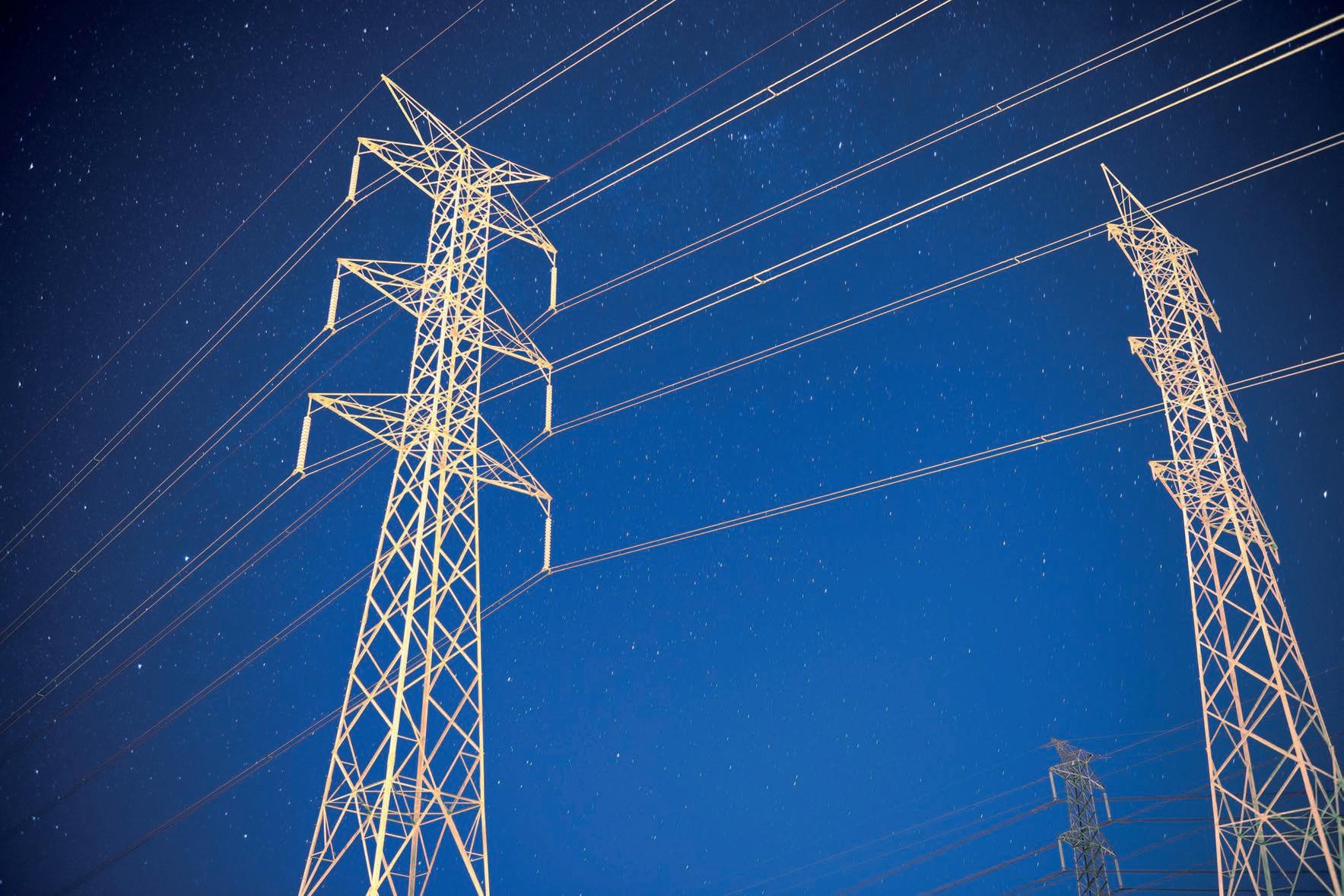
As Queensland prepares for energy transition, engineering and advisory firm Beca is looking to bring lessons from major renewables projects in other jurisdictions to bear.
With decades of experience at the front line of transmission design, stakeholder management, and decarbonisation, Beca says that a coordinated, pragmatic approach is critical if Queensland is to avoid the potential delays and stakeholder challenges that have been seen in projects down south.
With a wave of Renewable Energy Zone (REZ) development in the pipeline, timing is everything.
“Queensland has a big opportunity to get this right early,” says Rex Inger, Business Director for Transmission at Beca.
“What we’ve seen in Victoria and NSW is that when projects aren’t coordinated and when you’ve got different players engaging with communities and stakeholders in inconsistent ways, it leads to misaligned expectations and ultimately delays. The centralised role of Powerlink in Queensland could really help avoid that.”
Much of Beca’s recent work in the energy transition arena has been underpinned by its partnerships with Transgrid and EnergyCo in NSW. The Hunter Transmission Project (HTP), Project EnergyConnect, and the Victoria–NSW Interconnector (VNI) have all brought valuable insights into the technical, planning and stakeholder challenges facing large-scale grid upgrades and expansions.
“In the Hunter project, we helped identify a transmission corridor that ran mostly through crown land and mining leases,” says Harshal Patel, Beca’s Business Director for Renewables.
“About 80 to 85 per cent of the route avoided private landowners, which reduced the social impact and streamlined approvals. That kind of strategic land use planning is something we think Queensland could really benefit from.”
This lesson is rooted not just in design pragmatism but in political realism. Projects like HTP also had to adapt to community feedback mid-design, with routes adjusted to account for biodiversity, visual impacts, and agricultural activity. While Beca did not lead stakeholder engagement directly, Patel says their technical inputs shaped the options that were ultimately put forward for consultation.
According to Inger, inconsistent community engagement has been one of the biggest stumbling blocks for transmission rollout in NSW and Victoria.
“You had separate projects being managed in isolation, with different engagement approaches and compensation models. That created tension and confusion,” he says.
“Now with VicGrid and EnergyCo taking
on a centralised coordinating role, that’s helped to bring more consistency.”
Queensland, with Powerlink performing the function of the REZ delivery body as well as being the sole transmission operator, is well-placed to avoid fragmented engagement.
The state’s fast-track investment scheme – the Priority Transmission Investment Framework – streamlines planning, but may limit community stakeholder input.
“It’s efficient, sure, but there’s a risk there,” says Patel.
“Projects in NSW and Victoria have been burned by not getting early buy-in from communities. Queensland needs to strike the right balance – use the streamlined process, but not at the expense of proper engagement.”
From brownfields to bush
Beyond politics, Queensland presents an engineering challenge. The state’s vast, rugged geography brings an added layer of complexity to transmission design. Yet, Beca says advances in GIS (geographic information systems) and modelling technology are helping teams weigh up hundreds of route scenarios in a fraction of the time.
“We overlay terrain, flood risk, biodiversity, stakeholder interests, and more,” says Inger.

“These tools can produce heat maps that help identify optimal corridors. You can balance technical constraints with social and environmental factors then ground truth these before putting a single peg in the ground.”
He notes that the relative remoteness of some proposed Queensland projects could even work in their favour, reducing the number of impacted landowners and simplifying route selection.
Smart planning, smart tech
Technology also has a role to play in extracting more from existing infrastructure. In the VNI project, Beca helped implement SmartWire technology – equipment that redirects electricity flows in real time, unlocking grid capacity without new lines.
“It allowed us to defer major investments by balancing power flow more effectively,” says Patel.
“In Queensland, though, the transmission buildout is mostly greenfield, so SmartWires may have limited use. But there’s scope to look at uprating or repurposing existing lines where possible – like we did with the QNI [Queensland-New South Wales Interconnector] upgrade.”
Patel also points to practices in New Zealand, where transmission upgrades are often prioritised over new builds.
“They do a lot of tower upgrades, reconductoring and thermal uprating,” he says.
“It’s a cost-effective way to get more capacity out of the same footprint. We think Australia, Queensland included, could do more of that.”
Construction readiness and smarty supply
Beca is also advocating for earlier engagement with delivery partners to smooth the path to construction. In their NSW and Victoria experience, there is a real industry challenge in providing flexibility around the uncertainty in major project timelines.
“Contractors and industry delivery partners can’t efficiently ramp up and down based on shifting dates,” Inger says.
“If Queensland can offer more certainty –something Powerlink is well placed to do – it’ll help the whole supply chain plan. That’s a real drawcard for builders and engineers.”
Large construction contractors who are either re-entering the energy space or bringing experience from overseas, have been engaging in the market to support with the energy transition, however, the ability to stick to dates has proven elusive in other jurisdictions.
“Some of these contractors are used to established processes on government Transport projects that have historically had a lot more consistency of keeping to tender and construction start timelines,” Inger says.
That lack of certainty affects not only resource allocation but procurement of construction plant and long lead equipment.
“By identifying delivery partners earlier and achieving start dates, Queensland can help ensure critical resources are available when needed,” Inger says.
People, power and potential
Both Inger and Patel are candid about one of the biggest threats to the energy transition: the workforce shortfall.
From specialist high-voltage engineers to construction trades, Australia simply does not yet have the talent pool to meet demand.
“Transmission line engineers are in especially short supply,” Patel says.
“We haven’t built big transmission projects for decades, so there’s a generation of expertise that hasn’t come through. We’re competing globally for the same skills now.”
It’s a constraint that Queensland will need
to confront head-on. Beca recommends early, public commitment to project timelines to give training institutions and contractors the confidence to invest in capacity building.
Continuity counts
One of Beca’s strengths lies in team continuity. Inger points to the Project EnergyConnect rollout, where the same core team stayed on the job for over four years.
“That’s rare in this industry,” he says.
“And it makes a difference. You retain knowledge, maintain momentum, and reduce the time spent getting new people up to speed. It’s something we’re proud of.”
The company sees value in bringing this continuity to Queensland – particularly as projects scale and the state moves from planning to delivery.
Queensland’s harsh climate presents another test. Cyclones are getting stronger while flooding is increasing in frequency and intensity. That reality is shaping infrastructure design.
“All our designs factor in climate change,” says Patel.
“That includes modelling and consideration for severe weather events. Resilience is baked into the brief.”
Drawing on post-flood recovery experience in New Zealand, Inger highlights the importance of pragmatic design to consider climate resilience alongside appropriate planning for rapid response.
“The industry has learned a lot from recent severe weather events and we have come up with some great ways to mitigate future risks, however, there is a need to consider the efficient intersection of investment in mitigation vs. response planning” he says.
“We’re working with clients to both prevent the risks and be ready to act if it does happen.”
Beca’s ambition in Queensland is not just about growing market share. The company is keen to apply its hard-won set of insights to a region on the cusp of transformation.
“There’s no single blueprint,” says Patel.
“But there are smart, proven strategies – around land use, engagement, technical planning, resilience – that can give Queensland a smoother ride.”
For Beca, success in the Sunshine State will build on interstate wins, applying its understanding of how to build trust, certainty, and capability along the way.

Trina Storage, the energy storage division of solar leader Trinasolar, has reached a significant milestone with more than 2.4 gigawatt-hours (GWh) of utility-scale storage capacity under execution across the Asia-Pacific region (excluding China) as of July 2025.
Spanning Australia, Japan, Southeast Asia and South Asia, the latest Trina Storage deployments represent a substantial contribution to 16 gigawatt-hours (GWh) of new Battery Energy Storage System (BESS) capacity projected to be added in APAC (excluding China) in 2025, according to BloombergNEF.
As demand for grid-scale storage continues to accelerate across key APAC markets, Trina Storage has been selected to supply advanced BESS technology for several large-scale renewable energy projects. This includes 1.7 GWh of BESS for one of the region’s largest storage projects to date in South Asia, and 500 megawatt-hours (MWh) for Australia’s Limestone Coast North Energy Park.
These developments reinforce Trina Storage’s position as a trusted partner for utility-scale energy storage, capable of delivering complex, multi-phase utility deployments.
The projects are powered by the Elementa Series, a smart, fully integrated storage platform built with Trina’s in-house lithium iron phosphate (LFP) cells and designed to optimise performance from cell to grid. Manufacturing and developing its own LFP
cells enables enhanced control over quality, safety, and performance. Key features include a smart thermal management system that maintains cell temperature variation within three degrees Celsius, and auxiliary power consumption as low as 1.8 per cent.
These capabilities are engineered to reduce energy losses by up to 30 per cent compared to conventional systems, supporting higher system efficiency and potentially contributing additional usable energy annually.
With a reliable supply chain, proven technology, comprehensive performance guarantees and long-term warranties, Trina Storage ensures long-term system reliability and strong bankability. It has been listed among BloombergNEF’s Tier One energy storage manufacturers for six consecutive quarters and continues to rank top in BloombergNEF’s global storage providers and integrators bankability survey. Backed by global technical expertise with localised support, Trina Storage brings together bankable project credentials, compliance with international safety and performance standards (including IEC, UL, NFPA) as well as local standards and certifications (in countries like Australia and Japan), as well as
strong regional execution capabilities.
These strengths have been instrumental in boosting investor confidence and establishing Trina Storage as a preferred partner for utility-scale energy storage projects.
“Our growing presence across APAC reflects not only strong market demand but growing recognition of Trina Storage’s differentiated technology, delivery capabilities, and long-term reliability,” said Dr Leo Zhao, Head of Energy Storage at Trinasolar Asia Pacific.
“Trina Storage is well-prepared, with a full-scope delivery framework from manufacturing to commissioning. In key markets, we have established expert local teams who understand regional policies, grid requirements, and market dynamics. With proven technical strength and reliable project delivery, Trina Storage is setting new benchmarks for the global energy storage industry.”
With utility-scale projects underway across the region, Trina Storage continues to expand its footprint and support APAC’s clean energy transition through safe, high-performing, and future-ready energy storage solutions.




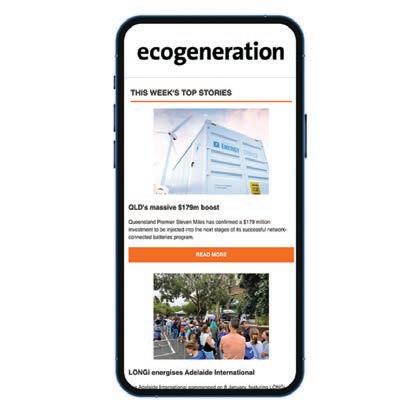

ecogeneration
Get
To
Fifteen years after entering the Australian market, inverter manufacturer Growatt is celebrating with the people who made its journey possible.
Growatt has taken the time to applaud the long-time residential users whose early adoption helped cement solar’s place on Australian rooftops.
The ‘One Decade Guest’ campaign was a national callout to households still using Growatt inverters installed before May 1, 2015. It generated enthusiastic responses, uncovering a surprising number of solar systems that have been quietly operating for more than a decade. In some cases, even longer.
“We saw many photos of older inverters still working after 11, 12, 13 years – even 14 years without permanent faults,” said Rex Wong, Marketing and Solution Manager at Growatt Australia.
“Some of them are still getting high feed-in tariffs. It’s amazing to see that kind of performance.”
Wong has been with Growatt’s Australian branch since 2017, almost half its operational life in the country.
He describes the campaign as both a celebration and a reality check – a rare chance to look back, test assumptions, and highlight what long-term solar ownership really looks like.
working daily and generating clean energy. That’s the most important part,” he said.
“It means the return on investment has already been met. It’s good for the family, good for the grid, and good for the planet.”
A homegrown start in a pioneering market
Founded in China in 2011, Growatt shipped most of its early production straight to Australia, making the local market its “dream launchpad”, according to Wong.
“Our founder, Yong Qiang Ding, put his whole career and resources into developing residential inverters. Australia was the very first market,” Wong said.
“Back then, the solar rebate was just taking off around 2009, and we were lucky to catch that trend.”
Growatt’s early products, including the popular ‘Sungold’ inverter, quickly found traction with local distributors.
“Australia’s solar market was one of the earliest and most dynamic globally,” Wong said.
“It had strong sun, strict regulations, and a very forward-thinking attitude towards remote monitoring and control.”
proved to be a benefit, not a burden.
“If you can meet Australian standards, it becomes much easier to enter other global markets,” he said.
For many of Growatt’s decade-long users, the story is as much about service as it is about the technology.
While the company has shipped multiple generations of inverters globally, it has always tailored its designs and support model to suit Australian conditions. That includes software and hardware tweaks for state-based rules like flexible export limits and emergency solar shutdowns.
Crucially, it also includes people.
“Ninety percent of our staff in Australia are service engineers,” Wong said.
“We run our support line seven days a week, and our hours are extended to cover the whole country.”
If an issue cannot be resolved remotely, Growatt works with installers or sends a technician. When necessary, they will provide refurbished units to ensure a site stays operational.
“This is how we’ve built trust. If you’ve

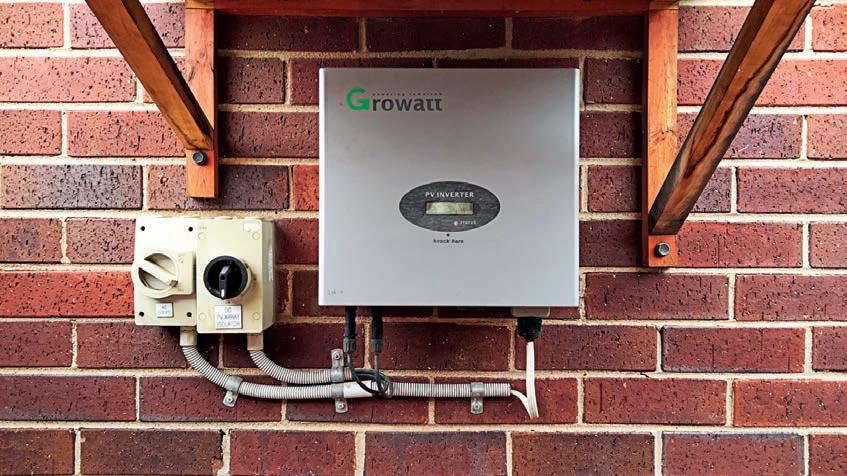
record, people believe in your brand,” he said.
Wong believes this commitment to after-sales support is the real foundation for Growatt’s longevity in Australia.
“It’s not just about selling inverters – it’s about being here for the long run.”
The ‘One Decade Guest’ campaign was not just a loyalty exercise. It became a proof point for Growatt’s core message: solar systems, when installed and supported properly, don’t just survive – they thrive.
The campaign invited eligible users to submit photos of their Growatt systems in exchange for a high-value portable power station. While the gift was a gesture, the response spoke volumes.
“Some people still have their old Growatt next to a new one, side by side,” Wong said.
“They’ve stuck with the brand and for me, that’s very exciting.”
There’s a technical takeaway too. With
most inverter warranties set at 10 years, the fact that so many are running well past that raises questions and expectations for future product lifespans.
The secret to decade-long performance lies in design and support.
“It starts with component quality, and all the simulation and testing we do in the lab,” Wong explained.
“But after that, it’s all about local service – supporting installers, resolving issues quickly, and making customers feel confident in their investment.”
Despite being a global product maker, Growatt says it builds for Australia from the ground up. Each generation of its inverter range has included localisation changes based on direct feedback from installers, regulators, and end users.
“We always ask: Is it easy to install? Is it
good-looking enough to match the house style? Will it work with the state’s grid rules?” Wong said.
“Only after we’ve answered those questions do we go to market.”
That approach continues with Growatt’s upcoming product releases, including the SPH 3600-6000TL-HUB hybrid inverter system which comes with a built-in smart meter and simplified install process.
“It’s an all-in-one solution that cuts down time on site. We’re very excited about that,” Wong said.
As the Australian energy market evolves, Growatt is evolving with it, leaning into battery integration, smart energy management, and grid compatibility.
From August, most new Growatt inverters will include battery capability by default, ready for direct connection without additional components.
“The demand for energy storage is growing fast, and we want to make it easy,” Wong said.
At the same time, Growatt is working with network operators across states like Victoria, South Australia and Western Australia to ensure its systems comply with increasingly complex rules. Flexible export, emergency limits, and voltage management are just some of the challenges.
“It’s difficult, to be honest,” Wong said.
“But we do our best to make sure our products are not just listed, but useful and usable across the whole country.”
While the technology keeps changing, the spirit of Growatt’s Australian story remains rooted in long-term relationships.
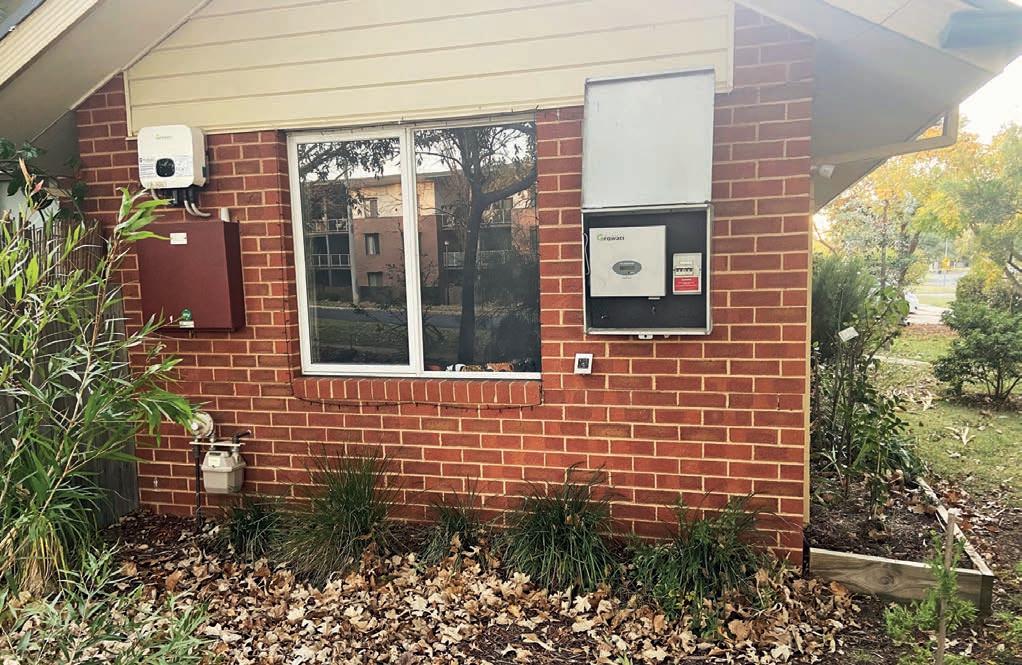
Wong says he still meets customers who proudly show him decade-old systems, often inherited or passed down within
“Some of them still have the old 150W panels – tiny by today’s standards – the systems still work, still power the home, and still offset bills,” he said.
For the team behind the scenes, that
“We’re not a company that wants to make a quick buck and disappear,” he said.
“Australia has supported us, and we’ll keep supporting Australia.”
In a market crowded with newcomers and shifting regulations, that kind of staying

The energy transition is speeding up, just as CIGRE Australia prepares for its landmark suite of conferences in 2025.
With a suite of summits packed into a few short days, CIGRE Australia’s events will show much more is needed, and quickly.
From 2–4 September 2025, Adelaide will host a packed program of high-level technical discussion, global insights and industry networking under the banner ‘Shaping the Power Systems of Tomorrow’.
Held at the Adelaide Convention Centre, the conference suite brings together the ninth South East Asia Protection, Automation and Control Conference (SEAPAC25), the sixth Conference on the Integration of Distributed Energy Resources (CIDER25), and a three-day general conference stream focused on the broad spectrum of challenges in delivering a decarbonised energy future.
It is not just one conference but several, co-located and coordinated to maximise engagement and impact.
“The scale of change required in our power systems is unprecedented,” says CIGRE Australia Chairman Seán McGoldrick.
“We’ve made strong progress decarbonising generation, but we now face the task of adding six times today’s utilityscale wind and solar, and five times today’s consumer energy resources, within 25 years…
all while maintaining the reliability that Australians rightly expect.”
Mc Goldrick’s comments reflect a key challenge for the sector – expanding renewable generation and managing the complexity that follows.
Distributed energy, digitalisation, market design, cybersecurity and grid flexibility all demand urgent attention and technical sophistication.
This year’s event is intentionally technical. With more than 150 presentations, tutorials and workshops across three days, attendees can expect deep dives into subjects that often receive only surface treatment at broader industry conferences.
“CIGRE’s value lies in its technical depth and collaboration,” says CIGRE Australia CEO Peter McIntyre.
“This event is unashamedly technical and jam-packed with insights for engineers, planners, regulators and market designers who are grappling with real-world system challenges.”
Conference highlights
The general conference stream will span six key areas: digitalisation; solar, wind and emerging energy sources; storage; hydrogen;
grids and flexibility; and consumers, prosumers and electric vehicles.
Each stream tackles a central issue in the transition from a legacy fossil-based system to one that is renewable, decentralised and dynamic.
One of three running in parallel, SEAPAC25 will explore the design and operation of protection, control and monitoring systems, with a strong focus on interfaces between primary equipment, SCADA and telecoms.
Meanwhile, CIDER25 will examine the integration of distributed energy resources (DER), with a spotlight on connection standards, network hosting capacity, customer-side control and demand-side flexibility.
The program also includes tutorials on DER from five perspectives – planning, operations, market regulation, integration and IT/cybersecurity – along with presentations on harmonics, power quality, digital twins and the interplay between market mechanisms and technical grid performance.
“We are seeing increasingly complex interactions between electricity markets and physical power systems,” said McIntyre.

“Australia’s high renewables penetration, especially rooftop solar, places us at the leading edge of many of these challenges. That’s why we’re bringing in both domestic and international expertise to share what’s working, and what’s not.”
Global lessons, local application
A major strength of the CIGRE format is its global knowledge-sharing. Delegates in Adelaide will hear directly from CIGRE President Professor Konstantin Papailiou, who will deliver a keynote on international energy transition trends.
Other headliners include Associate Professor Tim Nelson, Chair of the National Electricity Market (NEM) Review, and Nicola Falcon, incoming Executive General Manager of System Design at the Australian Energy Market Operator and a CIGRE Australia board member.
An important workshop will analyse recent major system disturbances in Spain and Peru – events that have prompted serious international reflection on renewable integration and grid resilience.
Australia’s own experience, particularly its world-leading rooftop solar uptake, continues to offer both lessons and warnings.
“In Australia, we’ve been forced to innovate,” said Dr Mc Goldrick.
“Our LV and MV networks have encountered the real impacts of high DER
penetration. We’ve made great strides, but the next phase is even more interconnected.”
Networking, inclusion and the next generation
Beyond the technical agenda, the conference suite will include social and professional events to foster dialogue across sectors and generations.
A Women in Energy-hosted leadership breakfast aims to elevate leadership diversity, while a NextGen Power Professionals seminar supports early-career engineers with personal and professional development.
The flagship gala dinner and welcome reception offer additional chances for delegates to connect with peers, suppliers, policy experts and project leaders from across Australia and internationally.
“Industry transformation requires people as well as technology,” said McIntyre.
“We need to build capability across
Dates: 2–4 September 2025
Venue: Adelaide Convention Centre, SA
the entire workforce – and ensure we’re bringing the best minds together to work on common problems.”
A growing audience
At the close of early-bird registrations in May, over 700 delegates had already signed up, indicating a strong appetite for deep technical exchange. That number is continuing to grow, with participation open to both members and non-members.
The event also overlaps conveniently with the Asia-Oceania Regional Council (AORC) meetings in New Zealand from 5–7 September, allowing international delegates to extend their trip across both.
“This is more than a conference… it’s a platform,” said Dr Mc Goldrick.
“It’s where we test ideas, share knowledge, and shape the technical roadmap for one of the most ambitious energy transitions in the world.”
Streams: SEAPAC25, CIDER25, General Conference
Keynotes: Prof Konstantin Papailiou, Assoc Prof Tim Nelson, Nicola Falcon
Extras: Tutorials, NGN Seminar, Women in Energy Breakfast, Gala Dinner
Website: www.cigreconference.com.au
Three of the most ambitious solar energy projects in Australia are lighting the path to a decarbonised national grid.
Stretching from Queensland’s Western Downs to the Northern Territory outback and New South Wales’ New England region – the scale of Australia’s solar ambition matches its opportunities.
Solar megaprojects face formidable challenges, yet they represent a powerful statement of intent: that Australia’s sunsoaked expanses can be harnessed not just to meet national energy needs, but to help power the Asia-Pacific region and anchor Australia’s net-zero ambitions.
Perhaps no project captures the ambition of utility-scale solar more than the AustraliaAsia PowerLink (AAPowerLink).
Originally envisioned by Sun Cable and now backed by a consortium of private investors under the leadership of Quinbrook Infrastructure Partners, the project aims to generate, store and transmit solar energy over astonishing distances from Tennant Creek in the NT to Darwin and undersea to Singapore.
Official documents say the solar farm component alone would cover approximately 12,000 hectares of land south of Elliott, in the Northern Territory – capable of delivering up to 20 gigawatts (GW) of peak solar generation with a storage system of up to 42 gigawatt-hours (GWh). The final configuration may evolve, but the scale remains without precedent.
“The Project will deliver renewable electricity at scale and at globally competitive prices,” Sun Cable stated in its environmental impact submission.
“It will demonstrate that renewable electricity is dispatchable and reliable at a national scale.”
According to the proponents, it is not just a solar farm; it is an export industry in the making.
The project proposes a 4200-kilometre high-voltage direct current transmission
system, including a 750-kilometre undersea cable, making it the longest power transmission system of its kind in the world.
The environmental assessment notes that the site was chosen due to its “very high solar irradiance and flat topography, and proximity to major transport and transmission corridors”, while also allowing for extensive land buffering and heritage protections.
The project has faced challenges, from financing to environmental scrutiny, but its supporters remain bullish.
“AAPowerLink will reduce greenhouse gas emissions and support a cleaner, greener economy,” the EIS concludes, calling the project “economically, socially and environmentally sustainable”.
While Sun Cable charts a futuristic vision, Neoen’s Western Downs Green Power Hub has already reshaped Queensland’s solar landscape.
With over one million solar panels across 1500 hectares near Chinchilla, the project is the largest operational solar farm in Australia and one of the largest in the Southern Hemisphere.
The 400 megawatt (MW) solar farm, built in partnership with CleanCo and Sterling & Wilson Solar, is now delivering more than 350 MW of clean energy to the Queensland SuperGrid via a new 275 kilovolt (kV) transmission line.
Once its adjacent 540 MW / 1080 megawatt-hour (MWh) big battery is completed, the hub will offer firmed, dispatchable solar power, crucial in a grid increasingly reliant on renewables.
“Having the largest solar project in the Southern Hemisphere here is something we’re super proud of,” Neoen says.
The project is expected to power the equivalent of 235,000 homes annually, producing more than 1080 MWh of clean energy.
According to the company, the project has supported hundreds of jobs at the site and injected millions in economic activity into the regional economy.
Cultural heritage has also been carefully considered. In 2019, Neoen and the Barunggam people signed a Cultural Heritage Management Plan (CHMP), recognising the project’s location on traditional lands.
“Neoen has committed to an ambitious 10 per cent Indigenous participation target for employment and supply chain procurement for the project,” the company noted.
The scale of the Western Downs project reflects a broader trend: Queensland is fast becoming a solar state. The hub’s visibility, both literal and figurative, positions it as a landmark in Australia’s energy transformation.
Solar power at elevation
In New South Wales, ACEN Australia’s New England Solar and Battery Project is bringing scale, storage and environmental sensitivity to the table.
Approved in 2020 and since modified, the project spans three large solar array zones east of Uralla, with up to 720 MW of AC generation capacity and a 200 MW / twohour battery energy storage system (BESS).
The site selection was far from arbitrary. The Environmental Impact Statement noted the combination of “relatively high solar irradiance in the order of 1830 kWh/m2,” “elevation of more than 1000 metres above sea level (MASL), which reduces heat losses and improves energy yield,” and “access to the existing 330 kV electricity transmission network” as key drivers.
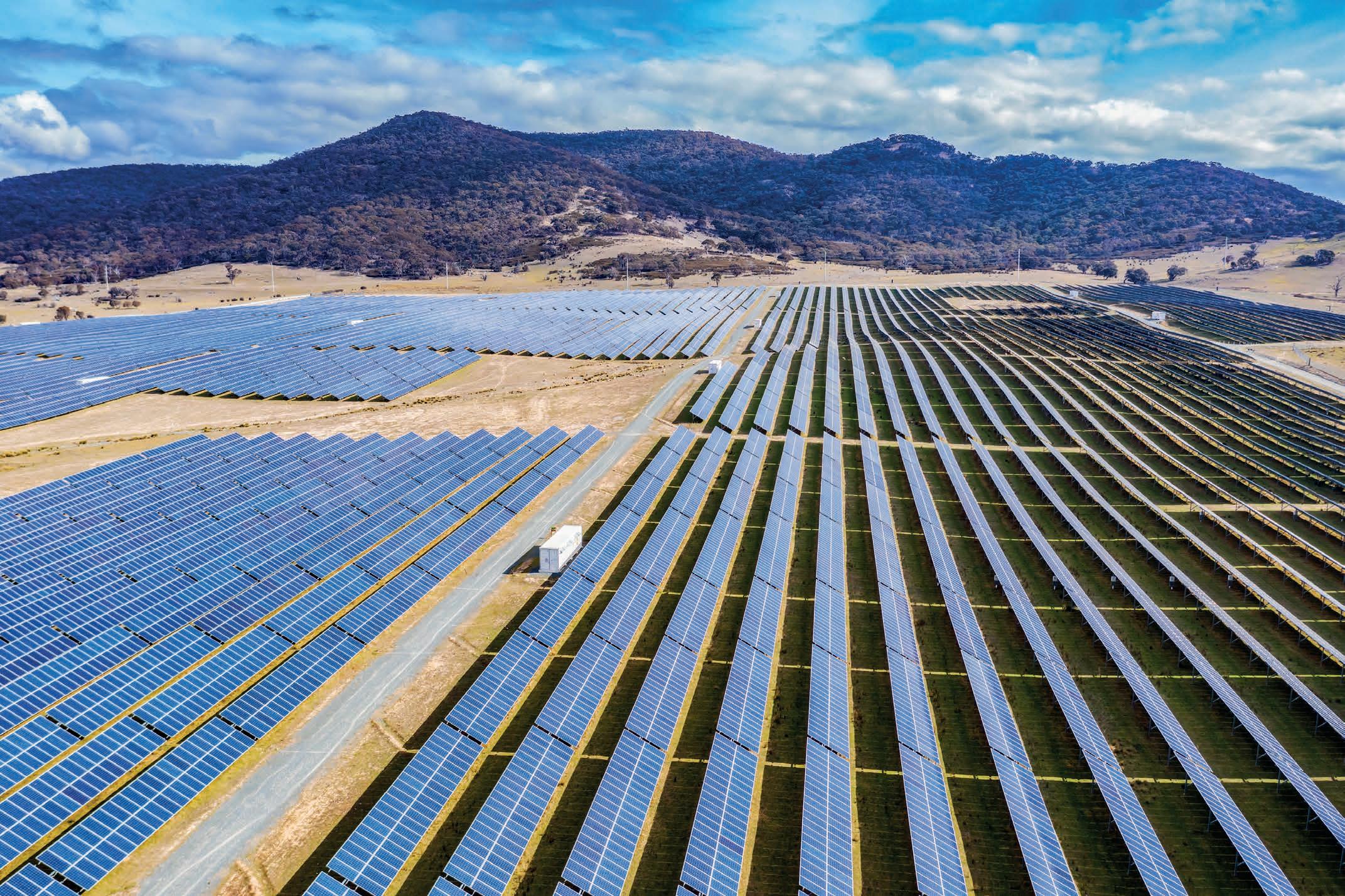
The EIS noted that the New England Solar Farm would generate up to 2000 GWh per year – enough to power approximately 250,000 households. Importantly, it will also “support the development of the New England region as a renewable energy zone (REZ)”, which has been formally

declared with a network capacity goal of eight gigawatts.
The project is being delivered in two stages to reduce the construction burden on local infrastructure.
“The project will provide a number of direct and indirect social, economic and environmental benefits,” the EIS noted, including “creation of employment opportunities, diversification of revenue streams and significant reductions in GHG emissions.”
Community and environmental feedback
has informed project refinement. Among the design changes were “exclusion of higher order streams from the development footprint”, “avoidance of Aboriginal Heritage Information Management System (AHIMS) listed sites”, and reductions to visual and noise impacts on nearby residences.
As ACEN noted in its 2023 submissions report; “The New England region of NSW has been selected by the NSW Government for the development of the New England REZ due to its significant natural energy resources”.
It is a recognition that the region’s future may be written in solar silicon as much as soil and stock.
Together, these three megaprojects showcase the breadth of utility-scale solar now unfolding across the continent: remote desert exports, regional grid support, and embedded generation within REZs.
Yet each also highlights challenges –cultural heritage obligations, community concerns, biodiversity offsets, connection delays, and the ever-shifting economics of solar hardware and storage.
Regional hubs are emerging as wind drives a deep energy transition.
Australia’s wind power sector is reaching new heights as Golden Plains claims the title of the country’s largest operating wind farm, while Queensland’s MacIntyre precinct builds out a renewable energy mega-hub on an unprecedented scale.
Utility-scale wind is moving from milestone to mainstream.
Last month, the Golden Plains Wind Farm in western Victoria surged to 560 megawatts (MW) of generating capacity, officially becoming the largest operational wind farm in Australia.
“It’s big, and it’s only getting bigger,” the project developers declared via LinkedIn.
That increase nudged it ahead of Stockyard Hill (530 MW), while also edging out Queensland’s fast-emerging MacIntyre Wind Farm, which remains constrained at its current commissioning hold point.
The two mega-projects are reshaping Australia’s grid from opposite ends of the National Electricity Market (NEM), but they share a broader significance: both are helping accelerate the transition to low-cost, low-emissions electricity at unprecedented scale and speed.
Located near Rokewood in the Golden Plains Shire, the Golden Plains Wind Farm is being built in two stages totalling 1.33 gigawatts (GW) of capacity – 756 MW in stage one and 577 MW in stage two.
With 560 MW now online, the $4 billion project is currently the most powerful operational wind installation in the country.
The project is sited on 16,739 hectares of farmland used primarily for broadacre cropping and grazing, with wind turbines designed to complement ongoing agricultural use. According to its Environment Effects Statement, only 1.5 per cent of the site is directly occupied by project infrastructure.
The location was chosen for its strong wind resource, proximity to existing highvoltage transmission (including the 500 kilovolt Moorabool to Mortlake/Tarrone line), and good access to the Port of Geelong for delivery of turbine components.
The project includes 228 turbines with rotor diameters of 150 metres and tip heights up to 230 metres. It is expected to generate over 3500 gigawatt-hours (GWh) annually
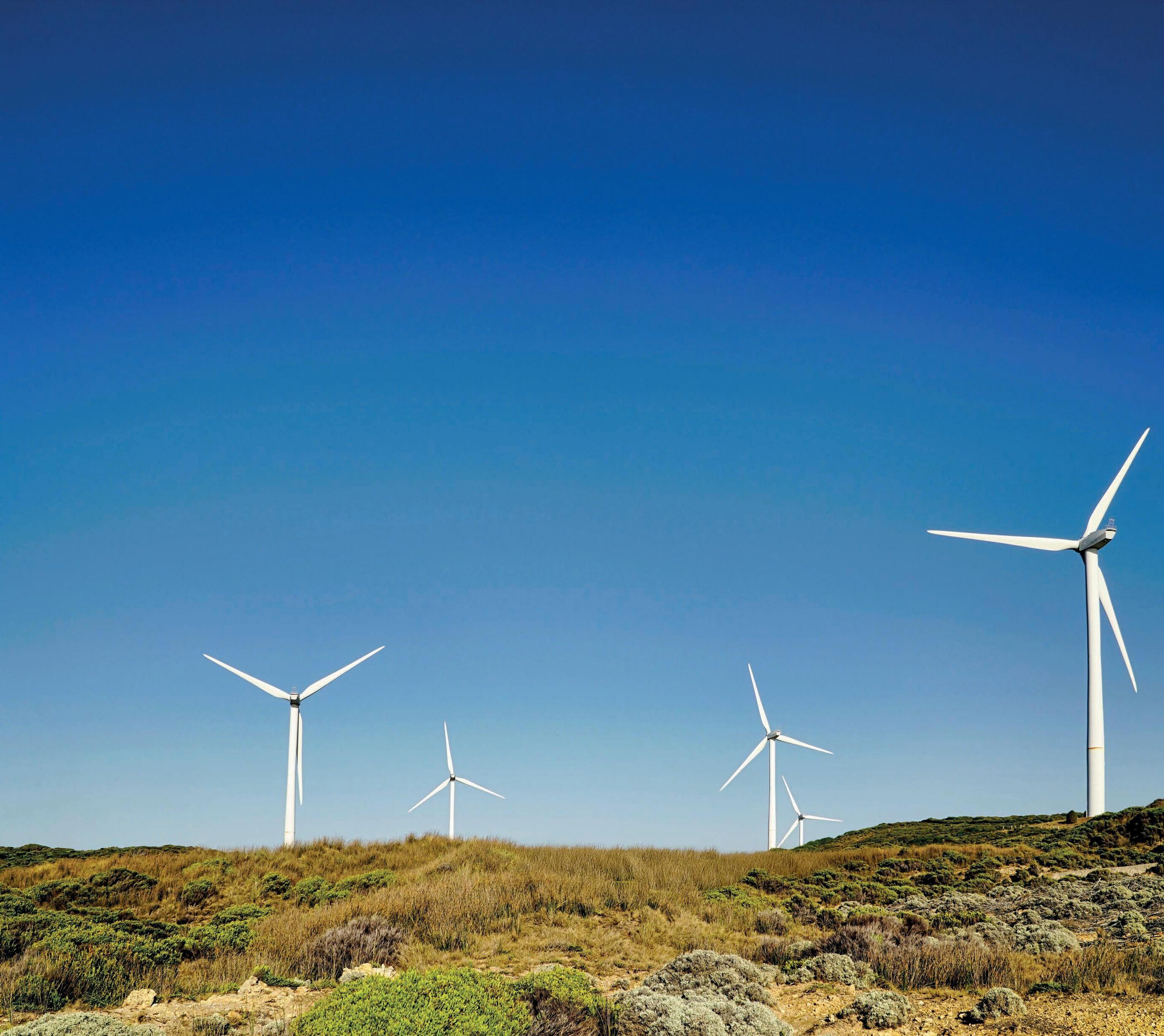
and offset more than 3.5 million tonnes of CO₂ (carbon dioxide) emissions each year.
The social benefits are also notable. The project supports about 200 construction jobs, 30 ongoing operational roles, and provides annual lease payments to 39 host landholders. A neighbour benefit scheme and a $228,000-per-year Community Benefit Fund further extend the project’s reach into the local economy.
WestWind, the project proponent, says the project’s scale is essential to achieving its low Levelised Cost of Energy (LCOE) target – below $60 per megawatt-hour (MWh).
“Achieving this low LCOE will provide downward pressure on prices and help to ease the pressure on electricity consumers throughout the NEM,” the project summary states.
MacIntyre:
Queensland’s wind frontier
Meanwhile, in Queensland’s Southern Downs, ACCIONA Energía is putting the finishing touches on what it describes as “one of the largest onshore wind farms in the world.”
The MacIntyre Wind Farm will deliver 923 MW from 162 turbines, with an expected annual output equivalent to powering 700,000 homes.
The project is the flagship component of the broader MacIntyre Wind Precinct, which also includes the 103 MW Karara Wind Farm, the proposed one GW Herries Range Wind Farm, and a 400 MW / 800 MWh battery energy storage system at Karara.
Together, they form a long-term renewable energy cluster integrated into Queensland’s Southern Renewable Energy Zone.
MacIntyre spans 36,000 hectares of sheep grazing land, and farming will continue alongside energy generation. Community cobenefits are central to the precinct’s long-term legacy. ACCIONA has committed over $2.5 million to local programs during construction, with ongoing contributions planned once the wind farm becomes operational.
A comprehensive Social Impact Assessment prepared for the project details over 20 specific impacts – from housing and accommodation pressure to mental health concerns – alongside detailed mitigation and benefit enhancement strategies. These include drought-proofing initiatives, scholarships, tourism infrastructure, and training pathways for local Aboriginal and Torres Strait Islander people.
The MacIntyre Wind Farm is also a landmark public-private partnership.
CleanCo, Queensland’s state-owned renewable generator, is independently developing the Karara Wind Farm and has signed a 10-year PPA to purchase 400 MW of MacIntyre’s output.
According to project documents, “this will help the state meet its decarbonisation
commitments and climate change mitigation strategies”.
While these megaprojects deliver carbon abatement and economic activity, they are also navigating new terrain when it comes to community interface.
At MacIntyre, the Social Impact Assessment flagged concerns about visual amenity, increased traffic, housing affordability, and road degradation. There were also concerns about water scarcity, mental health, and social division in the face of large-scale land-use change.
The project’s response includes a “shared value” model that aligns development with long-term community resilience.
Proposals include new firefighting resources, water infrastructure upgrades, and tourism investment. Critically, First Nations participation is embedded through employment targets and cultural heritage funding.
“Enhancing Aboriginal and/or Torres Strait Islander participation within each of the shared value recommendations has the potential to maximise the benefits,” the report notes.
Golden Plains, too, has integrated host and neighbour benefit schemes, as well as an annual Community Benefit Fund of $1000 per constructed turbine. Eligible residents within three kilometres of a turbine receive electricity bill offsets equivalent to that of an average fourbedroom home.
Both projects highlight the critical role

of transmission infrastructure.
Golden Plains is well positioned on an existing 500 kV line, easing its path to market. MacIntyre required new 330 kV overhead lines and a switching station, developed in coordination with Powerlink.
Even so, the project’s commissioning has been carefully staged, with AEMOcontrolled “hold points” limiting output as system integration progresses.
This coordination challenge will intensify as more projects come online. Future contenders for the “largest wind farm” title are already on the horizon.
Origin Energy’s 1.45 GW Yanco Delta Wind Farm has secured grid access in NSW’s south-west REZ. Others, like the Herries Range Wind Farm (one GW) and the Boulder Creek Wind Farm (up to 1.2 GW), are in development.
Golden Plains and MacIntyre represent more than a race to the top of the MW leaderboard.
They showcase how the next generation of wind projects are being designed not just to meet climate goals, but to contribute meaningfully to local communities, support regional jobs, and deliver long-term value beyond the turbine tips.
A
With the federal target of 82 per cent renewables by 2030, the nation must rapidly scale up not just clean generation, but the storage and transmission infrastructure that underpins it.
That means batteries, pumped hydro and high-voltage links on an unprecedented scale – delivering energy when and where it is needed, while phasing out coal and supporting a fast-changing grid.
This is the deep infrastructure behind the clean energy headlines, now beginning to take shape.
One of the nation’s largest energy storage efforts is unfolding in North Queensland, where the Kidston Clean Energy Hub is converting a disused gold mine into a hybrid renewable precinct.
At its centre is the 250MW (megawatts) Kidston Pumped Storage Hydro Project (K2Hydro) – Australia’s first new pumped hydro project in 40 years.
“The K2-Hydro Project is truly unique because it reuses existing mining pits as the upper and lower reservoirs,” the
developer Genex Power states.
“It will generate 250MW of power for up to eight hours for North Queensland”.
Beyond repurposing legacy sites, the Kidston Hub is also pushing innovation.
A planned 120MW wind farm will be paired with a 150MW/600MWh (megawatthour) battery in the final stage of the project. The integrated model aims to deliver dispatchable, low-emission electricity while adding “much needed system strength to the weak North Queensland grid”.
Another headline project is the Waratah Super Battery in New South Wales, backed by EnergyCo and designed to act as a “shock absorber” for the grid during major disturbances.
It joins AGL’s Torrens Island battery in South Australia (250MW with 250MWh of storage capacity) as the next generation of utility-scale batteries with critical roles in system security.
At the biggest end of the scale, Snowy 2.0 is billed as “the largest committed renewable energy project in Australia”.
Once operational, it will provide 2200MW of dispatchable capacity and around 350,000
MWh of storage – enough energy storage to power three million homes over the course of a week.
The megaproject links the Tantangara and Talbingo dams via 27 kilometres of tunnels, creating a closed-loop system that stores energy by moving water uphill when solar and wind are in surplus and releases it during peaks. As Snowy Hydro CEO David Evans puts it: “Snowy 2.0 is essentially a giant battery”.
The shift to inverter-based generation (solar, wind and batteries) is making traditional grid stability services harder to provide. That is where grid-forming batteries are starting to play a pivotal role.
Canadian Solar’s trial at Carwarp in the West Murray Zone, backed by ARENA, tackled the problem head-on.
“The West Murray Zone has reduced the available fault level which in turn has a negative impact on the network power system security,” official documents state.
The solution is to deploy a Battery Energy Storage System (BESS) using Grid
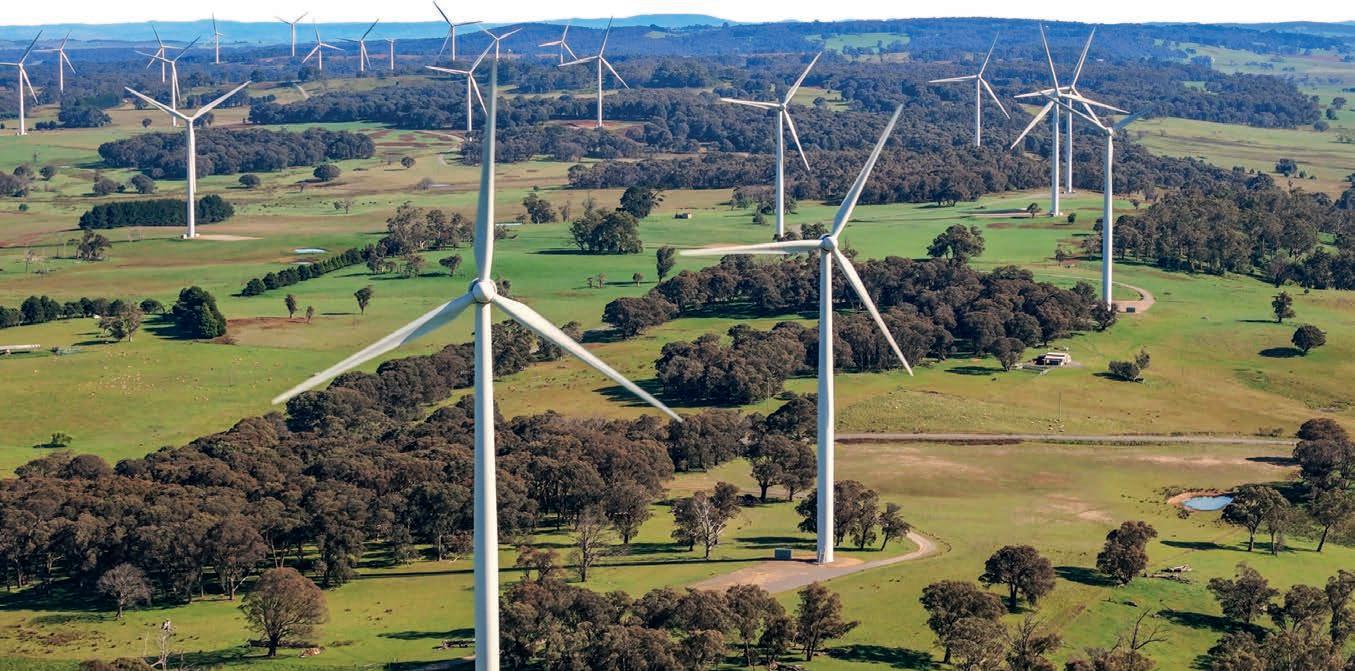

steady state and network contingency events,” the proponents say.
This approach reduces the need for costly synchronous condensers and could enable renewables to connect to weaker parts of the grid. As more such batteries are deployed, they are expected to shoulder more responsibility for voltage control, inertia and frequency response.
Transmission: Renewable Zones and storage potential
While generation and storage projects often get the fanfare, none of them work without wires.
AEMO’s Integrated System Plan (ISP) makes that clear: “Efficiently delivering the ISP’s actionable transmission projects is critical to unlocking the capacity of low-cost renewable generation and storage”.
Projects like HumeLink, Project EnergyConnect, VNI West, and Marinus Link are designed to knit together a future grid.
VNI West will increase transfer capacity between Victoria and NSW, while Project EnergyConnect links SA, NSW and (eventually) Victoria.
The most transformational of these may be Marinus Link, a proposed 1500MW high voltage direct current (HVDC) interconnector between Tasmania and Victoria, designed to tap Tasmania’s deep hydro and wind resources.
According to EY’s 2025 benefit report, Marinus Link would enable “a more resilient
regions: “Forecast gross market benefits in the Step Change scenario reach several billion dollars over 30 years”.
This progress has not come without friction, as the transmission rollout faces its own set of hurdles.
Challenges: Delay, disruption and the demos
While AEMO’s ISP maps a clear transition, the real-world rollout has faced persistent issues, including local opposition, planning hold-ups, escalating costs and strained community trust.
In the Kidston project, Genex says construction of the new transmission line corridor brought its own lessons in wildlife management and community consultation.
“Extensive consultation through the lifecycle of projects [is needed] to ensure communication and responsiveness with our communities,” Genex wrote, acknowledging the challenges of corridor alignment and environmental impact.
boring program.
Still on track to 82 per cent
Despite these headwinds, AEMO’s ISP remains confident in the long-term pathway.
“A diverse portfolio of storage, firming and transmission is the most cost-effective solution to meet reliability and emissions objectives,” it says.
That means batteries in cities and substations, pumped hydro in the mountains, and long wires crossing state lines. None of which work in isolation.
AEMO notes that delivering the full suite of projects in the optimal timeframe would reduce average consumer bills, cut emissions, and support reliability as coal exits the market. But delays risk creating reliability gaps and increasing system costs.
“This is a whole-of-system transition,” the ISP says.
“Progress relies on integrated delivery across governments, market bodies, communities and industry.”
Kidston Pumped Hydro: Announced 2015, construction from 2021, operational 2025
Snowy 2.0: Announced 2017, tunnelling began 2019, estimated completion 2027+
Waratah Super Battery: Announced 2022, operations expected in 2025
VNI West: RIT-T concluded 2023, full delivery planned by 2031
Marinus Link: Business case 2019, expected energisation by 2030
Project EnergyConnect: Construction began 2022, full delivery by 2026
Data centres might not be the first thought in the energy conversation, but they are fast becoming one of its most crucial players.
As artificial intelligence booms and compute requirements soar, data centres are emerging as both major electricity users, but they may also be untapped energy assets.
At Australian Energy Week 2025, Telstra Energy’s Head, James Gerraty, gave insight on what Telstra is doing to turn its data centres into engines of energy efficiency.
“We’re all concerned with what’s going to happen to our grid,” Gerraty said.
“There’s no shortage of capital looking for a home in data centres, and no shortage of compute requirements looking for a home –but are we doing enough thinking about the implications for the grid we have?”
Most people associate data centres with energy-hungry cooling systems and banks of blinking servers, but behind the scenes, they are also home to substantial power infrastructure such as backup generators, flywheels, and increasingly, large-scale batteries.
These are not just safety nets for blackouts, they are flexible assets that can be used to respond to market conditions.
“Over the last couple of weeks, we’ve seen prices at $10,000 or $15,000 a megawatt (MW), per hour,” Gerraty told the audience.
“More than 100 Telstra sites responded to that – discharging batteries, firing up generators – and reducing exposure to those prices.”
Telstra’s use of on-site assets recently offset around 100 MW of grid demand during peak events in Victoria, avoiding extreme wholesale prices and easing pressure on the market.
According to Gerraty, this responsiveness
delivered cost savings not only for Telstra, but also contributed to lower prices for other consumers.
“It’s not only saving us money. It’s saving all of you money,” he said.
“If you’re an energy consumer, then resources like this being brought to bear are not just good for us – they’re good for the system.”
Idle capacity, blocked potential However, much of the on-site generation capacity that could assist the grid during stress events is sitting idle, unused – not for technical reasons, but because of regulatory inertia.
“A 10 MW data centre might have 30 or 40 MW of capacity that it’s able to dispatch,” Gerraty said.

“But if you don’t have permission to export all of that to the grid, it counts for nothing.”
While Telstra has explored exporting from some sites, the processes involved have proven a major deterrent.
“It’s a real pain,” he said.
“Even in cases where the grid could absorb it and it would do great things for us all, we just find it too hard.”
This bureaucratic lag is holding back what could be hundreds of megawatts in dispatchable capacity – capacity that could play a vital role in firming a renewable-heavy grid.
As batteries become more central to energy infrastructure, questions around safety have come to the fore. Lithium-ion batteries, while efficient and widespread, carry welldocumented fire risks.
Gerraty acknowledged the growing scrutiny and called for more consistency in how safety is approached.
“Lithium batteries have been forming part of the solution for industrial use cases in Europe and elsewhere for a long time,” he said.
“But it’s only now that the safety conversation seems to be picking up.”
He argued the risks are often overstated, particularly when compared to the myriad small lithium batteries in consumer devices.
“There’d be close to a billion lithium batteries in different formats in Australia. You can still probably count on your hands how many make the news for safety issues,” he said.
Nonetheless, Gerraty said there’s a clear need for agreed best practices.
“It would be nice if emergency services and engineering bodies all had a consistent view on what’s best practice when deploying lithium batteries – whether in a house, a data

centre, or any facility,” he said.
“Now’s the time to get on the same page.”
Despite the challenges, the potential for data centres to support the grid is becoming more real. Telstra, for one, is looking beyond just backing up its operations. It is investigating how compute loads and cooling systems could be reshaped to better align with renewables.
“Compute requirements are essentially a battery where they’re not time-sensitive,” Gerraty explained.
“It’s easy to shift that into the middle of the day, when power prices are lower.”
The same goes for cooling.
“Historically, you’d run air conditioning based on temperature thresholds, regardless of price. But nothing stops us from running it harder in the middle of the day and backing off in the evening peak.”
This kind of load shifting could become a
major tool in managing grid stability as solar dominates daytime generation.
On the notion that data centres could be made more self-sufficient through on-site renewables, Gerraty is skeptical.
“Data centres are extremely energyintensive,” he said.
“If we covered every square metre of roof space at a Telstra facility with solar panels, we’d get to about two per cent of our energy requirements.”
He said some new regional sites may be able to co-locate ground-mounted solar to offset more of their consumption, but for the most part, grid dependence remains unavoidable.
Still, Telstra has taken major steps to reduce its net footprint, including signing contracts to generate renewable energy equivalent to 100 per cent of its consumption – mostly from wind and grid-scale solar farms.
As data centres grow in importance and scale so do the risks, making cybersecurity a key gatekeeper for technology adoption.
“You could have the most useful device I’ve ever seen,” Gerraty said.
“But if it relies on over-the-air communication or remote diagnostics, we can’t use it.”
He urged tech providers to consider these constraints up front if they want to sell into the sector.
“We’ve dismissed so many solutions simply because there’s no safe way to deploy them based on how they’re built.”
Gerraty sees data centres not just as energy consumers, but as latent contributors to a smarter, more resilient grid.
“The assets are there,” he said.
“The challenge now is to get out of our own way.”

Australian researchers have achieved a leap in energy storage by extending the lifespan of quantum batteries a hundredfold.
Quantum batteries are an emerging concept that use quantum states to store energy far more efficiently than traditional technologies.
One of the most promising designs, called the Dicke quantum battery, stores energy in special microcavities lined with light-sensitive molecules. These can charge extremely fast thanks to a phenomenon called ‘superabsorption’, where more molecules mean faster charging.
They also discharge just as quickly, unable to store energy for more than a few nanoseconds, but this may be changing.
A team at RMIT University and CSIRO has developed a prototype battery that overcomes this Achilles’ heel by redirecting the energy into molecular triplet states, which are long-lived, “dark” states that do not emit light.
In doing so, they have extended the energy storage time from nanoseconds to over 40 microseconds – more than a thousand-fold improvement.
“This is a big step forward in making

quantum batteries practical,” said Dr Francesco Campaioli, lead author of the study.
“By isolating energy in triplet states, we can store it for much longer without losing it to light emission.”
The device consists of a multilayer optical microcavity with donor and acceptor layers separated by a spacer.
The donor layer absorbs light and initiates the charge via superabsorption, while the acceptor layer traps that energy in stable triplet states.
This decouples the fast charging from the energy storage process –solving a major challenge in quantum battery design.
To demonstrate their approach, the researchers fabricated five different microcavities and tested their energy storage behaviour. One device achieved a self-discharge time of 40.3 microseconds –orders of magnitude longer than previous models. By aligning the energy of the triplet state with that of the system’s lower
polariton mode (a kind of hybrid light-matter state), the team was able to efficiently transfer and trap the energy.
The implications are significant for renewable energy and future electronic devices.
While the stored energy levels are still modest, the architecture is scalable, and future versions could be used in sensors, photodetectors, or even as rapid-charge storage for intermittent energy sources like solar panels.
The team also explored the concept of “ergotropy” – how much of the stored energy could actually be used. At the best setting, about half of the energy in the battery could be turned into useful power.
With further refinement, such as using materials with faster internal transitions or longer-lived triplets, the researchers believe it is possible to extend storage times to seconds or more.
The compelling proof of concept brings quantum batteries one step closer to realworld viability.


A new battery innovation from the University of Adelaide could reshape how we store renewable energy at grid scale.
Researchers have developed a dry electrode for zinc–iodine batteries that more than doubles the performance of existing iodine and lithiumion batteries, paving the way for a safer, cheaper and more stable storage option.
The technique sidesteps the long-standing problems of traditional iodine cathodes, which often suffer from poor stability and low capacity. Instead of wet-mixing iodine, which is prone to leakage and chemical loss, the team created a dry-rolled electrode that delivers exceptional energy storage performance.
“We mixed the active materials as dry powders and rolled them into thick, self-supporting electrodes,” said Professor Shizhang Qiao, Director of the Centre for Materials in Energy and Catalysis.
“This avoids the problems with iodine sublimation and low density in traditional processes.”
The result is a battery that can store up to 15.8 milliamp-hours (mAH) per square centimetre – more than three times the capacity of conventional lithium-ion cells.
In trials, pouch-style zinc–iodine batteries retained 88.6 per cent of their capacity after 750 charge-discharge cycles. Smaller coin cells kept nearly 99.8 per cent after 500 cycles.
The innovation did not stop at the cathode. To prevent zinc anodes from growing dendrites (tiny metal needles that can short out batteries) the team added a small dose of 1,3,5-trioxane to the electrolyte. This chemical forms a flexible, polymerbased film during charging, keeping the zinc surface stable even under high current loads.
“This dual strategy addresses two of the biggest challenges for aqueous zinc batteries: high active material loading and zinc stability,” said Dr Han Wu, a research associate on the project.
The benefits stack up quickly. The dry electrodes not only carry more energy but reduce self-discharge and resist the chemical “shuttling” that often plagues iodine batteries. The in-situ polymer film means batteries last longer and can be charged and discharged more aggressively without degrading.
Because they use water-based electrolytes
and avoid flammable materials, zinc–iodine batteries are safer than lithium-ion alternatives. Zinc and iodine are both abundant and inexpensive – zinc is mined locally in Australia, while iodine is plentiful in seawater. The researchers say the technology offers real cost and sustainability advantages.
The study, published in the journal Joule, was supported by the Australian Research Council and used advanced measurement tools at the Australian Synchrotron.
The team believes the approach could soon scale up for commercial use, with potential applications ranging from solar storage in remote communities to stabilising electricity grids.
Professor Qiao said future work will look at lighter components, reel-to-reel manufacturing, and adapting the technique for bromine batteries.
“We’ve developed a platform that could shift how large-scale, safe batteries are made,” he said.
“This is a critical step toward a more resilient renewable energy future.”
As Australia races to meet its Net Zero targets, the pace of renewable energy infrastructure development is accelerating, but so are community concerns.
Transmission lines, wind farms and solar installations are transforming regional landscapes at unprecedented scale and speed, often stirring unease in communities left feeling sidelined or confused.
Enter New South Wales Energy & Water Ombudsman (EWON), Janine Young, whose office is positioning itself as a critical bridge between developers and the communities hosting this infrastructure.
“We’ve seen 40 complaints come in since the energy transition team was established in December,” Young told the audience at Australian Energy Week 2025.
“That might not sound like much, but it doesn’t mean the system is working. What it shows is that people don’t know we exist. They don’t know who to complain to.”
As large-scale renewable energy zones (REZs) reshape regional NSW, Young’s team is focused on building trust through transparency, fairness, and better community engagement.
When ministers opted not to create a standalone energy ombudsman for renewables, NSW’s existing EWON was handed the reins. The rationale was to maintain its independence, experience, and an established reputation for fairness.
With 25 years under its belt, EWON was seen as the logical choice to take on the new jurisdiction. Its new six-person energy transition team now investigates complaints linked to the transmission infrastructure underpinning the clean energy rollout – projects like Project Energy Connect, HumeLink, and VNI West.
“We can’t stop these projects, and we can’t slow these projects down,” Young said.
“[But] we can investigate complaints from individuals who are directly impacted by the new transmission infrastructure.”
More than just an escalation service, the ombudsman’s office is fast becoming a hub
for information, advice, and connection. It often acts as a warm referral to other agencies when issues fall outside its jurisdiction.
Unlike traditional utility complaints like billing errors or meter issues, grievances tied to renewables are layered, complex, deeply personal, and the emotional stakes are often high.
One case involved a landowner who had long engaged with a solar developer, only to find the project moved to a neighbouring property.
“All of a sudden, the benefits that this first customer was going to get, were going to go to the neighbour,” said Young.
“But he’s the one with the view of the solar farm.”
The ombudsman wrote to the developer, urging them to consider neighbourhood payments or other gestures of goodwill.
She said: “I’m not sure whether I’ll be successful, but if you don’t ask…”
Another case concerned a man worried about land acquisition and drone activity
near a planned substation.
EWON clarified the legal framework, confirmed no drones had flown over his land, and explained the lack of road upgrade requirements.
“He indicated he was going to continue to pursue the land the road improvements. He accepted that the drones he’d seen were not transmission related,” Young said.
What these cases illustrate is the human side of the energy transition. Not just contracts and compliance, but landowners trying to make sense of what is happening in their backyard, and how to live with it.
“One landowner told us that for months he couldn’t even go down to the pub for a Friday night beer. His mental health was suffering. He felt like there were strangers in his backyard every day – and for years to come,” Young said.
Getting engagement right
Despite developer claims that few complaints indicate smooth operations, the ombudsman sees it differently.
“We’re hearing, ‘I’ve never heard of you before,’” Young said.
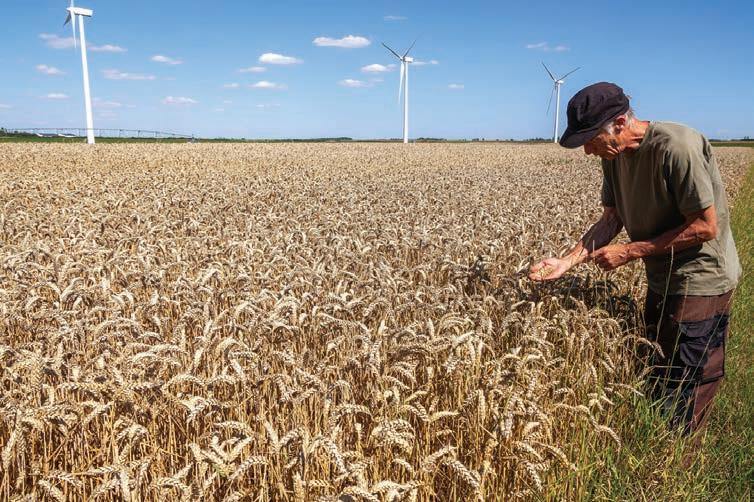

“That’s not a sign everything’s going well – it’s a sign people aren’t aware of their rights or the complaints process.”
To counter that, EWON has rolled out a comprehensive community engagement program, hosting drop-in sessions in NSW towns like Dunedoo, Gulgong and Mudgee.
The outreach is about listening, not just being seen.
“There’s a disconnect between what industry tells us and what communities are saying,” she said.
“A lot of it comes down to the language we use… the jargon, the acronyms. We’ve really got to find a better way to talk about this.”
Communities want to be heard and they want meaningful consultation, not just box-ticking.
“They tell us their knowledge isn’t being taken into account,” said Young.
“If you sit on someone’s veranda for half an hour, you’ll learn more than from a consultant’s report.”
For councils, the situation is often fraught.
“They can see the potential benefits for their shires, but they also know some in their community don’t want the projects at all. They’re caught in the middle,” Young said.
Toward a better complaints culture
One of EWON’s goals is to shift how complaints are perceived – from threat to asset.
“We love the data complaints give us,” Young said.
“They show us what’s not working and help us fix systemic issues. If we get it right, we can actually reduce complaints in the long run.”
Convincing developers of this can be tough.
“Industry sometimes tells me we’re trying to build an empire of complaints. But

we’re not. We want them to promote their own complaints processes – and then refer unresolved issues to us.”
She believes that kind of transparency fosters trust.
“If a company tells a customer, ‘We’ll try to solve it, but if we can’t, here’s the ombudsman,’ that puts their credibility on the line. But it builds trust,” Young said.
One area of concern is land access.
Landowners have reported “joke” offers for access rights, unclear tax implications, and long periods of disruption.
“Some don’t realise just how long these projects take… years, not months. And that can wear people down,” Young said.
There is also tension between individual and community benefits.
“There’s a big focus on childcare centres or playgrounds,” Young said, “but communities want actual community benefits that are going to be long term.”
While NSW is taking the lead, Young sees value in a nationally consistent approach.
“There’s a strong desire among ombudsmen to collaborate. We need to share learnings and avoid duplicating effort,” she said.
Currently, EWON’s jurisdiction covers only the transmission build, but it is in talks with the Department of Climate Change, Energy, the Environment and Water to expand coverage to solar and wind farms. Offshore wind may be next.
“We all share the same objective: we want to get to Net Zero. But how we do it matters,” Young said.
“We need a culture of recognition and respect, and that starts with listening.”
Clean Energy Council presents
15–16 September 2025
Brisbane featuring large-scale solar and storage
Don’t miss the Queensland Clean Energy Summit featuring large-scale solar and storage.
With abundant sunshine, wind and storage options , Queensland has the opportunity to lead the world’s renewable energy transformation. In 2024 alone, the state attracted more than $2 billion in clean energy investment and led the nation in rooftop solar installations.
However, rapid policy change and shifting investment conditions are creating an increasingly uncertain future for renewable energy projects in the Sunshine State.
Join the most influential leaders and voices and delve into the challenges and opportunities unique to the Sunshine State’s clean energy transition at the Queensland Clean Energy Summit featuring large-scale solar and storage.
Held in Brisbane on 15–16 September 2025, this 2-day event also features a stream focused on Australia’s large-scale solar and storage sector,
with conversations focused on the pivotal role these technologies play in accelerating Australia’s journey towards a clean energy future.
Join us for a stellar line-up of exceptional thought-leadership, educational and networking experiences including the summit dinner.
Across two tailored streams, the program will feature real-world case studies and expert-led discussions on:
•Community engagement and transmission
• Utility-scale solar and battery storage
• Grid integration, policy challenges and delivery at scale.
Don’t miss your chance to attend.


NAVIGATING VOLATILE PPA MARKETS PG52
WHY SOLAR CUSTOMERS CHOOSE BATTERIES PG54
UPSKILLING FOR THE RENEWABLES BOOM PG56

According to the Clean Energy Council, Australia’s transition is accelerating –but without a modern, skilled and mobile workforce, the transition risks stalling.
The clean energy industry is growing up fast. According to our latest Quarterly Investment Report (at the time of writing), there are 82 renewable electricity generation projects and 69 storage projects in Australia that have either reached financial commitment or are under construction. Yet, the pace at which we are building still needs to increase significantly. By 2030, it’s estimated we’ll need an additional 40,000 workers, the majority of which will be tradespeople, from electricians and technicians to drone pilots and crane operators. We’ll need to attract workers from adjacent industries and under-represented groups, we’ll need more apprentices, and we’ll need to do a lot of training.
At the same time, we must continue to mature as an industry. With clean energy now supplying over 40 per cent of Australia’s electricity, the renewable sector is no longer the new kid on the block and will soon be the
leader. We must continue to develop leading workforce standards that keep pace with emerging technologies, increase productivity and meet the highest possible safety levels.
For over a year at the Clean Energy Council we have been working with developers, contractors, governments, training organisations and workforce experts to help address some of these issues and in June we launched Clean energy, job ready, a program with new tools to help employers manage workforce compliance and clear pathways for workers and students to build their careers in clean energy.
The first industry-agreed training guide for trade roles on clean energy projects
Building and operating a wind, solar or battery project requires a huge range of construction, electrical and mechanical trades. Each role will have mandatory training required by
law or regulatory standards and additional training that is either an accepted norm or an individual preference from the employer. Through workshops with employers held across Victoria and Queensland we discovered quite a lot of variation in these additional training requirements.
Through consultation, we’ve created the Training Matrix, the first industry-agreed training guide for trade roles on solar, wind and battery projects in Victoria and Queensland. It describes over 50 common trade roles and both their mandatory training requirements and common additional training required across the industry.
This is the first step towards harmonising training requirements across our industry–driving consistency, lifting safety standards, and reducing inefficiencies. Employers and training organisations can download the Training Matrix for free, reference it and customise it for their projects.

A worker skills passport to help build a compliant, modern and mobile workforce
Some trade roles contained a huge number of training requirements. An electrician working on a clean energy site will typically need a Certificate III in Electrotechnology Electrician, an up-to-date white card, driving licence and state electrical licence, some core units of competency and then often additional licences for forklifts, dogging and nonslewing mobile cranes as well as up to 17 other units of competency. Ensuring compliance as an employer quickly becomes a complex task, particularly on sites involving multiple contractors and sub-contractors. We wanted to establish a tool that could help workers share verified credentials easily with employers and help employers to easily manage workforce compliance across multiple sites and sub-contractors.
We talked with a dozen companies delivering workforce compliance solutions for industries but one stood out beyond all others. MyPass have built a Skills Passport
that is worker-centric, allowing workers to transfer easily across projects, employers and industries, and already established in the mining and energy sectors. They verify all qualifications, notify users of expiring licences and offer employers complete and real-time oversight of worker credentials.
MyPass have now integrated our Training Matrix into their suite of employer tools and are offering Clean Energy Council members six months free on their Premium Plan.
Whether you’re a local tradesperson living near a renewable energy zone, an electrician exploring roles on clean energy sites, a seasoned rigger looking to transition out of the oil industry, or a TAFE student planning their future career, you should be able to easily find the training you need for roles in clean energy.
We took the Training Matrix and made two Career Pathways tools to do just that.
On the Clean Energy Council website you’ll find a simple tool where you can
pick from roles on solar, wind and battery projects and discover the training commonly needed for those roles. On MyPass workers can explore a customised version of the Career Pathways tool, showing how their existing qualifications align with typical requirements on clean energy sites.
Join us to help build a modern, skilled and safe workforce
We have begun the journey to streamlined training requirements and modern workforce compliance and are indebted to the dozens of organisations and partners who have helped developed the program especially MyPass, TAFE Gippsland, Federation University, Energy Skills Queensland and the Victorian and Queensland governments.
We would encourage all developers, contractors, training organisations and workers involved in building the clean energy transition to explore the Clean energy, job ready tools at cleanenergycouncil.org.au/job-ready and help us build a modern, skilled and safe workforce.
Australian businesses face a growing challenge: how to meet decarbonisation goals while electricity prices rise.
Since June 2021, retail prices have climbed by 40 to 50 per cent, driven by increased wholesale, fuel and network costs. These pressures are forcing many commercial and industrial (C&I) energy users to rethink their approach to procurement, balancing emissions targets against cost.
While some have deferred sustainability goals in favour of operational savings, others are using renewable Power Purchase Agreements (PPAs) to secure lower-cost, lowcarbon energy. With the right structure, PPAs can reduce emissions exposure and deliver cost certainty, even in a volatile market.
From retail to 24/7: Understanding the PPA landscape PPAs are no longer exclusive to the largest corporates. Supermarkets, tech firms,
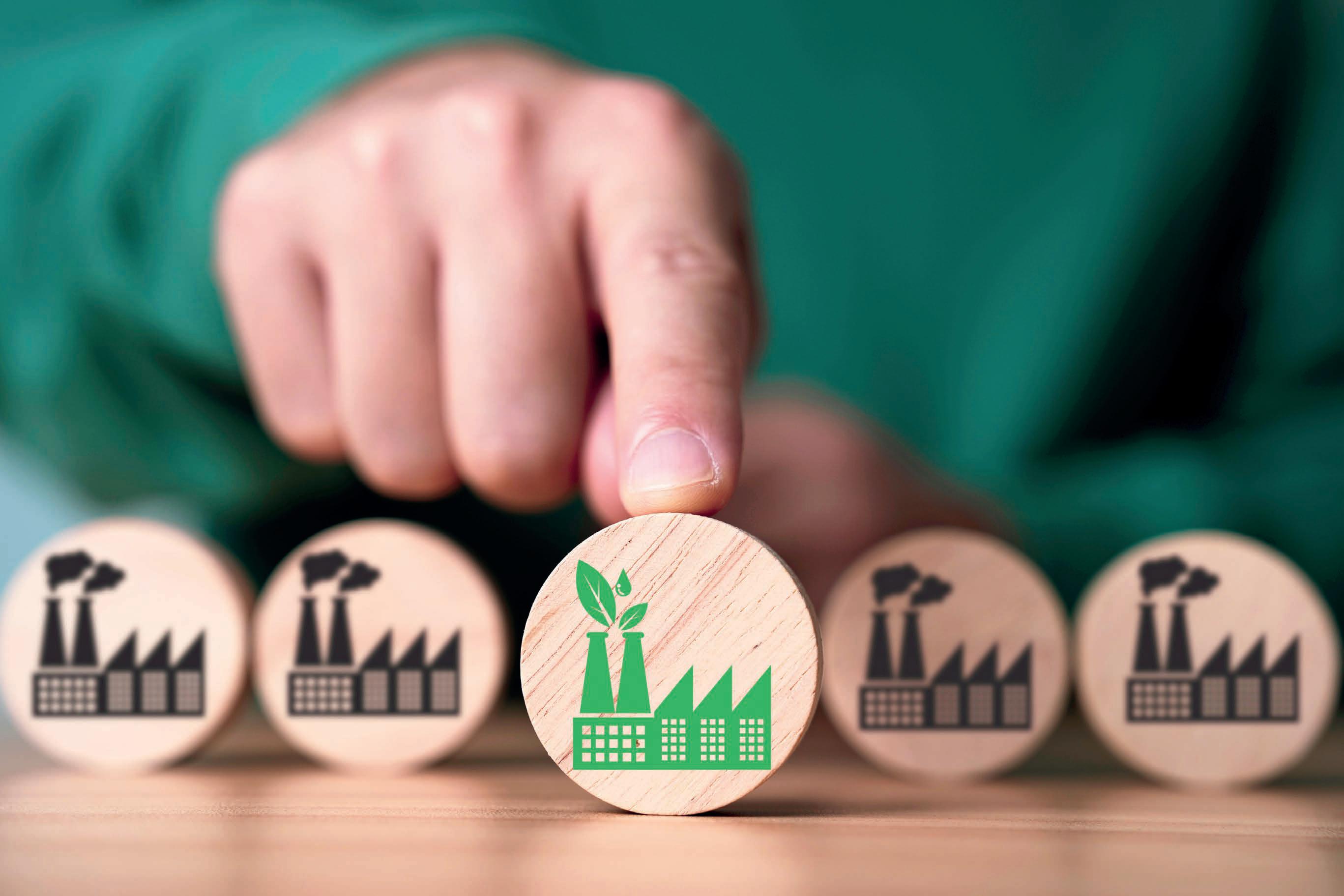
airports, aged care and manufacturers are all now active participants. Buyers typically choose between a retail contract, where the retailer manages all electricity supply and firming, or a hybrid of wholesale and retail agreements that require more buyer involvement.
The most common entry point is the fully firmed retail PPA. This delivers predictable pricing over one to five years, with the retailer handling firming. It suits smaller or mid-sized buyers wanting simplicity, though the cost per megawatt-hour (MWh) is higher due to retailer margin.
Progressively firmed retail PPAs give buyers more control, allowing them to lock in prices for time-based blocks linked to ASX futures. They require some procurement capability to manage spot market exposure, but can unlock savings if timed well.
For buyers ready for deeper engagement, tripartite PPAs involve a long-term agreement with a renewable generator and a separate retailer deal for firming and sleeving services. This reduces dependence on retailers for energy supply but demands greater internal expertise. A recent example is the 10-year agreement between ZEN Energy, ACEN Renewables and BOC, covering 23 per cent of ACEN’s New England Solar Farm output.
Fully wholesale PPAs remove the retailer entirely. C&I customers contract directly with project developers for energy and firming, either bundled or via separate agreements. Edify Energy’s PV-BESS hybrid project with Rio Tinto is an example of bundled firming, while Rio’s separate contracts with European Energy and Windlab show the alternative approach.
These deals can deliver the lowest cost per MWh, but require strong internal energy management and long-term commitment. At the frontier are 100 per cent renewable and 24/7 PPAs. These contracts require energy usage to be matched by renewable generation either over a month or in real time. The 24/7 model tightens alignment further, requiring hourly or daily timematching, usually firmed with storage rather than gas. Though more complex and expensive, 24/7 PPAs offer the strongest carbon integrity. They are increasingly sought by RE100-aligned corporates and high-reliability sectors like data centres, including Equinix, which signed a 15-year PPA with TagEnergy’s Golden Plains Wind Farm in 2024.
The ideal PPA structure depends on a buyer’s internal capability, risk appetite, budget priorities and procurement horizon. Buyers with limited internal expertise tend to favour fully-firmed retail PPAs, while those with moderate capability can manage progressively firmed or tripartite deals. Fully wholesale and 24/7 PPAs demand advanced in-house capability or trusted advisors.
Risk tolerance also matters. Fully firmed contracts provide price certainty but cost more. Progressively firmed and tripartite options carry some exposure. Fully wholesale

contracts come with the highest risk during periods of over- or under-generation unless backed by storage or hedging.
Cost priorities influence contract choice. Fully firmed PPAs offer predictability, while wholesale PPAs offer lower costs for those able to manage complexity. 24/7 PPAs are typically chosen for their emissions transparency and brand value, not cost savings.
Market access and availability vary. Firmed retail options are widely available and fast to execute. Tripartite and wholesale contracts are more bespoke, requiring longer lead times and multiple counterparties. 24/7 PPAs remain rare and require time to secure.
Contract duration is also a factor. Retail PPAs run for one to five years, while wholesale and tripartite agreements often span 10 or more. Rio Tinto’s PPAs run 20 years or longer.
Emissions outcomes differ across structures. Carbon alignment depends on real-time matching, certificate surrender volumes, and whether the deal supports new renewable capacity. 24/7 PPAs lead on all three counts, but involve higher cost and greater complexity.
A global top 10 mining company aimed to power its Australian operations with 100 per cent renewables by 2030 and cut operational
emissions by 30 per cent – without paying a green premium. Working with CORE Markets, the company evaluated three options: a fixed supply agreement, a volumematching PPA, and a PPA with minimal market exposure.
Parallel RFPs were issued to both retailers and generators, with all offers stress-tested under conservative pricing and demand scenarios. Financial, emissions, and LGC outcomes were quantified to give decisionmakers a clear basis for comparison.
The result was a 10-year retail PPA delivering 100 per cent renewables from 2025 (five years ahead of target) while saving approximately A$3.9 million per year (real 2022 dollars) compared to the existing tariff. Crucially, the company achieved this without paying a green premium and with full boardlevel buy-in.
As more renewable capacity and transmission projects come online, electricity prices may ease, but volatility will remain. In this environment, buyers who treat energy procurement as a live, strategic process and not a one-off transaction are best positioned to manage cost and carbon together.
Staying informed about contract structures, market signals and timing will be essential.
In Australia, over 40 per cent of households have installed rooftop solar systems, reflecting the widespread adoption of residential solar power.
Australia’s increased grid penetration has led to challenges such as voltage and frequency fluctuations and solar curtailment, where excess electricity is wasted due to low demand. Solar Energy Storage (SES) systems offer a viable solution by enabling households to store surplus energy for later use, thereby reducing reliance on the grid and enhancing energy independence. A new study investigates the socio-economic, environmental, and technical factors influencing SES adoption using a qualitative methodology through semi-structured interviews with adopters and non-adopters. Findings indicate that reducing electricity bills and increasing self-sufficiency are major motivators, while technical complexity, lack of awareness, and high upfront costs act as barriers. Additionally, government policies, environmental consciousness, and installer trust significantly impact adoption
Technical Drivers
Behavioural Drivers
Social Drivers
Economic Drivers
decisions. The study highlights the need for policy interventions, public education, technological advancement, and better supply chain coordination to foster SES adoption and facilitate the transition toward a sustainable energy system.
Residential rooftop photovoltaic (PV) systems are increasingly common in Australia, allowing homeowners to generate electricity from solar panels installed on rooftops. These systems capitalise on the photovoltaic effect to convert sunlight into usable electrical energy, supporting either partial or full household energy demands. Households often export surplus energy to the grid through net metering or feed-in tariff (FiT) arrangements. While this contributes to carbon emissions reduction and lower utility bills, the over-reliance on grid connectivity results in inefficiencies, particularly during peak solar production times. With more than 40 per cent of
• Innovation and integration
• Grid optimisation
• Smart Energy Consumption
• Infrastructure Resilience
• Environmental Awareness
• Stimulation of the Learning Process
• Consumer Perspectives
• Awareness and Perception
• End-User Behaviour and Perception
• Allied Technologies
• Market Dynamics
• Enhancing the Financial Viability of Storage
• Government Incentives and Policy Support
Australian homes equipped with rooftop solar, challenges such as power quality degradation and solar curtailment are becoming more pronounced. SES systems provide a way to mitigate these issues by enabling storage of excess energy for use during night time or grid outages, thereby

enhancing household energy autonomy. Batteries reduce dependence on grid electricity and improve the effectiveness of rooftop solar by preventing excess generation losses. Despite the potential benefits, SES adoption remains limited due to various social, economic, and technical constraints. This research investigates behavioural and decision-making factors influencing SES adoption among end users in Australia. It aims to explore the motivations and barriers from the perspective of consumers navigating the rapidly changing energy landscape. This qualitative study employs semi-structured interviews to collect primary data from three user groups: adopters of rooftop solar only, adopters of both rooftop solar and SES, and non-adopters. The methodology allowed for flexibility in responses while ensuring that essential topics such as motivations, barriers, and perceptions were consistently covered across all interviews.
Participants were selected through purposive sampling to represent a variety of demographic and geographic segments. Thematic analysis was used to analyse the interview transcripts, allowing researchers to identify recurring themes and divergent perspectives. This method facilitated an indepth understanding of the socio-technical landscape influencing SES adoption in WA.
A declining FiT makes exporting excess solar energy to the grid less financially attractive. As a result, storing that energy for later use increases its value, helping households reduce electricity bills. Another key driver is energy independence. Batteries allow households to use their self-generated power even during grid outages or at night, increasing their autonomy and resilience. Many participants emphasised this benefit, especially in areas where grid reliability is a concern.
Environmental consciousness also played a significant role. Several adopters noted that the ability to contribute to emissions reduction and use cleaner energy sources was a core value influencing their decision. These adopters often saw themselves as early technology adopters with a strong commitment to sustainable living. In some cases, adopting SES was associated with social status or keeping up with peers who had already installed the technology. Participants also acknowledged that interest in related green technologies, such as electric vehicles (EVs), reinforced their decision to install SES. The integration of storage with solar and EV charging was seen as a comprehensive approach to sustainable energy use. Social and environmental awareness, combined with economic rationality, formed a holistic motivation for many adopters. Figure one illustrates the key factors influencing the adoption of Solar Energy Storage (SES) systems.

Despite its benefits, SES adoption faces significant barriers. The most prominent obstacle is the high upfront cost of battery systems. Many participants indicated that the long payback period deterred them from investing, especially when compared to the earlier appeal of rooftop solar systems, which were often subsidised more heavily. Another concern is the technical complexity of SES. Interviewees mentioned confusion around battery terminology, such as depth of discharge, charge cycles, and integration with inverters
These factors contribute to a perception that SES is difficult to understand and operate without specialised knowledge. Lack of awareness was cited as another major issue. Even among those who could afford SES, many were unaware of how the systems work, their benefits, or available support. Participants also expressed concerns about the credibility of installers, particularly when companies acted as both retailers and installers. This dual role sometimes led to skepticism about product recommendations and installation quality. The limited availability of products and long waiting times for installation further discouraged some potential adopters. Participants noted that waiting several months for installation led to a loss of interest.
Stakeholders along the supply chain –including suppliers, retailers, and installers – were urged to ensure product diversity, availability, and timely service. Trust in installers emerged as a crucial factor. Participants expected them to be wellinformed, transparent, and supportive. Installers who lacked up-to-date technical knowledge or failed to communicate effectively risked losing customer confidence. Figure two illustrates the key factors hindering the adoption of Solar Energy Storage (SES) systems.
The need for standardised training and certification for SES installers was emphasised as a way to build end-user trust. Government policies and incentives were considered pivotal in facilitating SES adoption. The reduction in FiTs, while a financial driver for storage, also highlighted the need for new forms of support. Many participants called for updated subsidies, rebates, or low-interest financing options specifically for SES. Participants also stressed the importance of public education campaigns. Many were unaware
of existing programs or regulatory changes that could affect their adoption decisions. Clearer communication from government agencies and energy providers was identified as a way to bridge the awareness gap. Australia’s unique position with its high solar penetration and reliable grid infrastructure makes it a valuable case study for global energy authorities and can serve as a model for managing decentralised energy systems.
Social and technical considerations
The research emphasises that SES adoption is not purely a technical or economic decision; it is deeply socio-technical. Individual values, peer influence, trust, environmental concerns, and policy frameworks all interact to shape adoption behaviour. There is significant potential for SES systems to contribute to the creation of virtual power plants (VPPs), where distributed energy resources are aggregated to provide grid services. This could reduce infrastructure costs associated with poles and wires, ultimately benefiting both utilities and consumers. The increasing uptake of EVs also points to a future where SES plays an even more integral role in energy management. For SES to reach its full potential, ongoing innovation is needed not only in technology but also in business models, service delivery, and stakeholder engagement. Retailers and installers must be supported through training and incentives, while consumers need to be empowered through education and transparent information.
The study reveals that SES adoption in WA is influenced by a complex interplay of economic, social, environmental, and technical factors. While motivations such as cost savings, energy independence, and environmental concern are strong, they are often undermined by high costs, technical challenges, and a lack of awareness. Government intervention, in the form of updated policies and educational efforts, is essential to address these barriers. A more coordinated approach across the supply chain is also needed to ensure timely access to products and trustworthy service. Ensuring installer competency, diversifying product offerings, and improving communication will enhance user experience and confidence.
Australia, with its high solar penetration and evolving grid needs, is uniquely positioned to lead in SES adoption. Lessons learned from WA can inform energy transitions globally, particularly in remote or decentralised systems. Future research may benefit from financial modelling to better understand SES value and optimise incentive structures. Ultimately, SES has the potential to drive a new era of sustainable energy, reduce grid dependence, and empower consumers. Addressing adoption barriers through policy reform, technology development, and public engagement will be key to realising this potential.
Dr Nikhil Jayaraj - Research Adjunct, Faculty of Business
and Law, Curtin University
• Constraints of Existing Technology
• Lack of Knowledge and Education
Technical Barriers
Behavioural Barriers
Social Barriers
Economic Barriers
• Compatibility and Integration Issues
• Regulatory and Approval Hurdles
• Installation and Safety Concerns
• Lack of Awareness and Knowledge
• Relative Advantage of Existing Technology
• Social Norms and Influences
• Negative Expert Reviews
• Lack of Legitimate Professionals
• Lack of Government Policies and Support
• Lack of Financial Sense
• Supply Chain Challenges

ADVERTISE IN
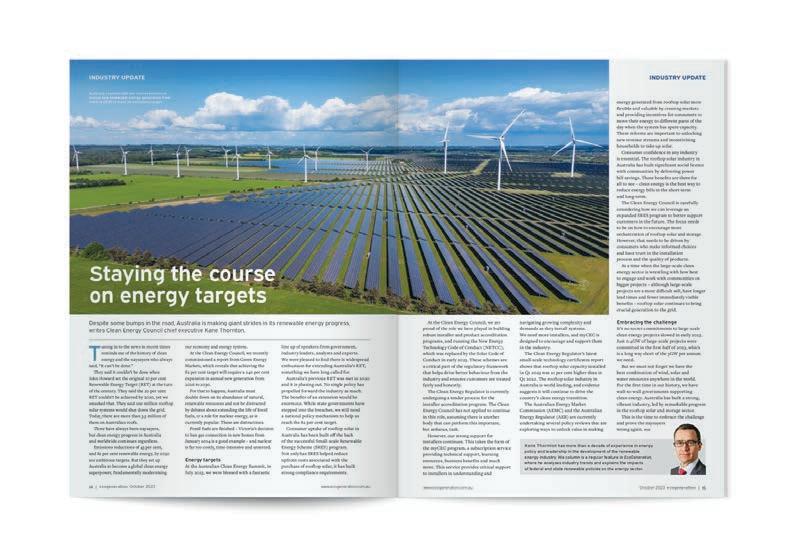
EXPERT COVERAGE OF THE PROJECTS AND DEVELOPMENTS THAT ARE RESHAPING THE AUSTRALIAN ENERGY MARKET.
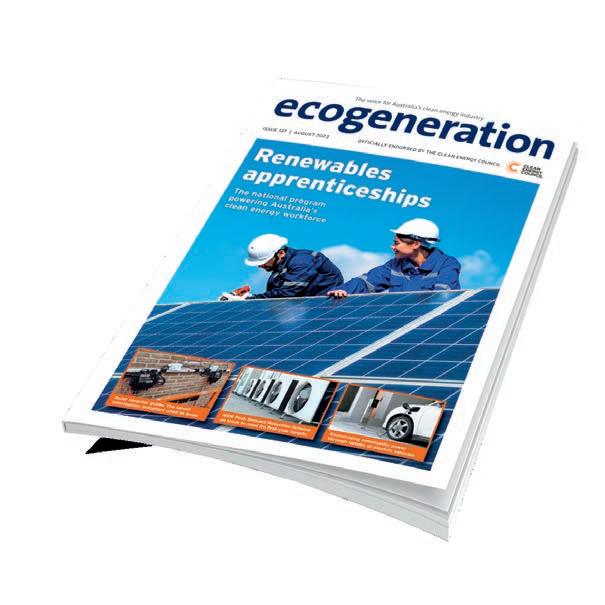
23,000+ COMBINED CIRCULATION

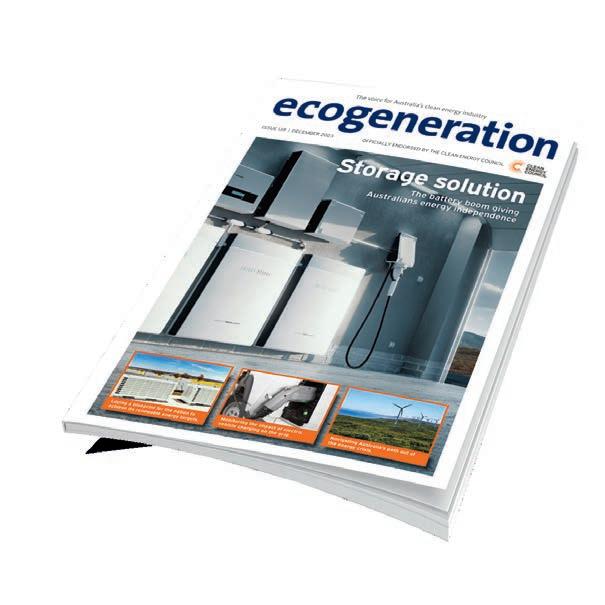
Our magazine, e-newsletters and website are valued at all levels of the industry, from financiers and developers to installers and suppliers. As the energy market transitions to renewables, our readers look to ecogeneration.
ecogeneration is the only title in Australia to cover all aspects of the clean energy industry; delivered across print, online and email. The bi-monthly magazine, officially endorsed by the Clean Energy Council, keeps the industry informed from the boardroom to the work van.
The print and digital magazine, and pass on rate, has a combined circulation of more than 23,0000, as well as receiving extra distribution at important industry events.
For more information, please contact: Nick Lovering Business
Development Manager
nick.lovering@primecreative.com.au 0414 217 190
